JazzEE(2)
- 8、异常
- 引入try-catch
- catch中如何处理异常
- try-catch-finally
- 多重catch
- 异常的分类
- throw和throws区别
- 小案例
- 重载和重写的异常处理
- 自定义异常
- 9、常用类
- 包装类
- 引入
- Integer
- String类
- String字符串内存
- StringBuilder类
- 可变和不可变
- 常见方法
- StringBuffer和StringBuilder区别
- 时间处理的类
- Date
- 日期转换
- Calendar
- Math
- 枚举类
- 10、集合
- 数据结构
- 集合引入
- Collection接口
- 第一个子接口List
- 实现类:ArrayList
- 源码
- 自己模拟一个ArrayList
- 将自定义的引用数据类型存入ArrayList集合
- 实现类:Vector
- 泛型
- 基本应用
- 扩展:
- 泛型类:
- 泛型方法:
- 泛型接口:
- 泛型受限:
- 实现类:LinkedList
- 基本代码
- 扩展
- 模拟LinkedList
- 面试:iterator(),Iterator,Iterable关系
- ListIterator
- 第二个子接口Set
- HashSet
- 深入理解HashSet
- 复习
- TreeSet
- 完整结构图
- Map接口
- HashMap
- TreeMap
- Map结构图
- 源码
- HashMap,HashSet
- TreeMap,TreeSet
- 验证红黑树
- Collections工具类
- 11、IO流
- File类
- IO的引入
- 最终:文件的复制
- 分解:文件----》程序
- FileInputStream
- 分解:程序----》文件
- FileOutputStream
- 将上面两步骤合为一起:完成复制
- 编码总结
- 节点流,处理流:BufferedInputStream,BufferedOutputStream
- 字符流:FileReader,FileWriter:文件的复制
- System类对IO流的支持
- 转换流
- 数据流:专门操纵基本数据类型的
- 对象流:专门操纵引用数据类型的
- 文件夹的复制
- 12、多线程
- 程序,进程,线程
- 线程创建的三种方式
- 第一种:继承Thread类
- 设置线程名字
- 龟兔赛跑
- 买火车票
- 第二种:实现Runnable接口
- 扩展:静态代理模式
- 龟兔赛跑
- 买火车票
- 第三种:实现Callable接口
- 总结
- 线程的生命周期
- 控制线程常用方法
- 优先级
- join
- sleep
- yield()
- setDaemon
- stop
- 线程安全、通信,线程池
- 线程安全问题
- 习题
- 线程同步的缺点
- Lock锁
- 线程组
- 线程之间的通信问题
- 分解1:
- 分解2:
- 分解3:
- 线程池
- 队列
- 线程池
- 内置线程池
8、异常
引入try-catch
【1】完成求商功能:
public class Test {
public static void main(String[] args) {
//功能:键盘录入两个数,求商。
//拿来一个扫描器:
Scanner sc=new Scanner(System.in);
System.out.print("请从键盘录入第一个数:");
int num1=sc.nextInt();
System.out.print("请从键盘录入第二个数:");
int num2=sc.nextInt();
//求商:
System.out.println("商为:"+num1/num2);
}
}
【2】测试:

在测试过程中,发现程序很可能出现问题。
在正常的程序中出现不正常的现象—》异常。
【3】将程序的漏洞都堵上:处理异常:if_else形式
public class Test {
public static void main(String[] args) {
//功能:键盘录入两个数,求商。
//拿来一个扫描器:
Scanner sc=new Scanner(System.in);
System.out.print("请从键盘录入第一个数:");
if(sc.hasNextInt()){//判断第一个数是否是int类型数据
int num1=sc.nextInt();
System.out.print("请从键盘录入第二个数:");
if(sc.hasNextInt()){//判断第二个数是否是int类型数据
int num2=sc.nextInt();
if(num2==0){//如果第二个数为0,那么进行提示:
System.out.println("除数不能为0!");
}else{
//求商:
System.out.println("商为:"+num1/num2);
}
}else{
System.out.println("请录入一个整数!");
}
}else{
System.out.println("请录入一个整数!");
}
}
}
上面用if-else堵漏洞,有什么缺点吗?
(1)代码臃肿。
(2)即使我加了很多if-else进去,很可能出现一种情况就是有的漏洞没堵上。
【4】基于上面的缺点,java给我们提供了一种处理异常的机制:
"异常三连"try-catch-finally
【5】try-catch:
在上面的异常中,控制台上的异常怎么看:
(1)看第一行:异常的类型。
(2)看最后一行:异常出现的位置
上面的代码出现了几种异常:
(1)Exception in thread “main” java.lang.ArithmeticException: / by zero
(2)Exception in thread “main” java.util.InputMismatchException
捕获:处理:try-catch:
public class Test2 {
public static void main(String[] args) {
System.out.println("------开始使用计算器:-------");
try{
//功能:键盘录入两个数,求商。
//拿来一个扫描器:
Scanner sc=new Scanner(System.in);
System.out.print("请从键盘录入第一个数:");
int num1=sc.nextInt();
System.out.print("请从键盘录入第二个数:");
int num2=sc.nextInt();
//求商:
System.out.println("商为:"+num1/num2);
}catch(Exception ex){
System.out.println("你的程序有错啊!");
}
System.out.println("---谢谢你使用计算器---");
}
}
可能出现情况:
(1)我的代码没有异常:那么只走try中代码,然后不走catch,程序继续往下走。
(2)我的代码有异常:
a.假如你的异常对象 catch后面()中的类型可以匹配,异常进行捕获,执行catch后面{}中的代码
b.假如你的异常对象 catch后面()中的类型不匹配,异常不可以进行捕获,直接抛出异常,程序中断,之后的代码也不会再执行了
catch中如何处理异常
public class Test2 {
public static void main(String[] args) {
System.out.println("------开始使用计算器:-------");
try{
Scanner sc=new Scanner(System.in);
System.out.print("请从键盘录入第一个数:");
int num1=sc.nextInt();
System.out.print("请从键盘录入第二个数:");
int num2=sc.nextInt();
//求商:
System.out.println("商为:"+num1/num2);
}catch(Exception ex){
//第一种:什么都不写。
//第二种:自定义异常信息:
//System.out.println("你的代码有问题!");
//第三种:打印
//System.out.println(ex);//java.util.InputMismatchException 证明Exception中重写了toString方法。
//System.out.println(ex.toString());
//System.out.println(ex.getMessage());打印:后面的异常信息
//ex.printStackTrace();//异常的堆栈信息全部进行打印
//第四种:
//throw ex;将信息抛给调用者,在当前这个题里,调用者为虚拟机,那么就将处理异常的方式抛给
//虚拟机了,虚拟机做了:(1)将异常堆栈信息进行打印 (2)中断程序
}
System.out.println("---谢谢你使用计算器---");
}
}
try-catch-finally
/*
1.System.out.println("---谢谢你使用计算器---");在什么情况下不执行:
(1)throw ex;
(2)catch没有进行正常的异常捕获
(3)遇到return
2.怎么才能让System.out.println("---谢谢你使用计算器---");无论如何都执行:
finally
3.一般什么代码放入finally中:
关闭数据库资源,关闭IO流资源,关闭socket资源。
4.只有一种情况会让finally中的代码不执行:
System.exit(1);// 终止当前正在运行的 Java 虚拟机。
5.return和finally是否冲突?不冲突:
执行顺序先finally再走return
*/
public class Test3 {
public static void main(String[] args) {
System.out.println("------开始使用计算器:-------");
try{
Scanner sc=new Scanner(System.in);
System.out.print("请从键盘录入第一个数:");
int num1=sc.nextInt();
System.out.print("请从键盘录入第二个数:");
int num2=sc.nextInt();
//求商:
System.out.println("商为:"+num1/num2);
//加上return
return;
//System.exit(0);// 终止当前正在运行的 Java 虚拟机。
}catch(ArithmeticException ex){
System.out.println("你的代码有问题!");
}finally {
System.out.println("---谢谢你使用计算器---");
}
}
}
多重catch
/*
多重catch:多个catch依次匹配执行,Exception接收放在最后,一般都是先子类,再父类。
*/
public class Test3 {
public static void main(String[] args) {
System.out.println("------开始使用计算器:-------");
try{
Scanner sc=new Scanner(System.in);
System.out.print("请从键盘录入第一个数:");
int num1=sc.nextInt();
System.out.print("请从键盘录入第二个数:");
int num2=sc.nextInt();
//求商:
System.out.println("商为:"+num1/num2);
}catch(ArithmeticException ex){
System.out.println("除数不能为0!");
}catch(InputMismatchException ex){
System.out.println("输入的类型不是整数类型!");
}catch(Exception ex){
System.out.println("代码出现问题!");
}finally {
System.out.println("---谢谢你使用计算器---");
}
}
}
在源码中看到,还有这种写法:
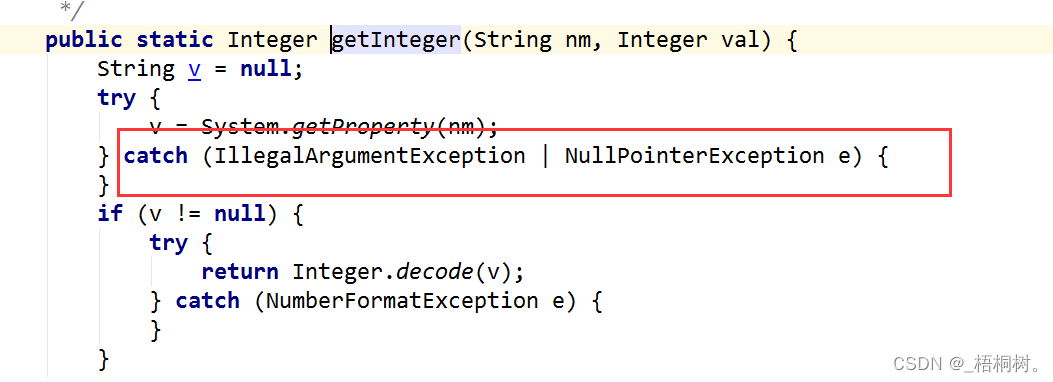
异常的分类
【1】层次:

【2】代码:
package com.bjsxt.test02;
public class Test {
public static void main(String[] args) throws ClassNotFoundException, IllegalAccessException, InstantiationException {
//运行时异常:
//int[] arr={1,2,3};
//System.out.println(arr[3]);//运行时异常:ArrayIndexOutOfBoundsException
//int num=10/0;
//String s=null;
//String newStr=s.toUpperCase();
//System.out.println(newStr);
//检查时异常:防患于未然,在我编写代码的时候直接就让我处理异常。
//第一种处理方式:利用try-catch进行捕获。
/*try {
Class.forName("com.bjsxt.test01.Test").newInstance();
} catch (ClassNotFoundException e) {
e.printStackTrace();
} catch (IllegalAccessException e) {
e.printStackTrace();
} catch (InstantiationException e) {
e.printStackTrace();
}*/
//第二种处理方式:在方法的声明处将异常类型添加上,意味着别人在调用这个方法的时候:
//告诉别人这个方法中可能会出现哪种错误。
Class.forName("com.bjsxt.test01.Test").newInstance();
//快捷键:alt+enter
}
}
throw和throws区别
package com.bjsxt.test02;
import java.util.Scanner;
/*
throw跟throws区别:
(1)位置不同:
throw:方法内部
throws:方法的声明之后
(2)内容不同:
throw+异常对象
throws+异常的类型
(3)作用不同
throw:异常出现的源头
throws:在方法的声明处,告诉方法的调用者 这个方法中可能出现某种异常,那么谁调用谁处理。
*/
public class Test2 {
//功能:两个数相除,当除数为0的时候 让程序出现异常。
public static void main(String[] args) {
try {
a();
} catch (Exception e) {
e.printStackTrace();
}
}
public static void a() throws Exception {
devide();
}
public static void devide() throws Exception {
Scanner sc=new Scanner(System.in);
System.out.print("请从键盘录入第一个数:");
int num1=sc.nextInt();
System.out.print("请从键盘录入第二个数:");
int num2=sc.nextInt();
if(num2==0){//除数为0
//制造异常:
//制造运行时异常:
//throw new RuntimeException("除数不能为0");
//制造检查时异常:
throw new Exception("除数不能为0");
}else{//不等于0 就输出商:
System.out.println("商为:"+num1/num2);
}
}
}
小案例
package com.bjsxt.test03;
public class Student {
private String name;
private int age;
private String sex;
public String getName() {
return name;
}
public void setName(String name) {
this.name = name;
}
public int getAge() {
return age;
}
public void setAge(int age) {
this.age = age;
}
public String getSex() {
return sex;
}
public void setSex(String sex) throws Exception {
if("男".equals(sex)||"女".equals(sex)){
this.sex = sex;
}else{
//不正常,制造异常:
//throw new RuntimeException("你的性别录入错误!");
throw new Exception("你的性别录入错误!");
}
}
public Student(String name, int age, String sex) {
this.name = name;
this.age = age;
//this.sex = sex;
try {
this.setSex(sex);
} catch (Exception e) {
e.printStackTrace();
}
}
public Student() {
}
@Override
public String toString() {
return "Student{" +
"name='" + name + '\'' +
", age=" + age +
", sex='" + sex + '\'' +
'}';
}
public static void main(String[] args) {
Student s=new Student();
s.setAge(19);
s.setName("lili");
try {
s.setSex("lkjhlkjhlkj");
} catch (Exception e) {
e.printStackTrace();
}
System.out.println(s);
Student s2=new Student("feifei",20,"asdfasdf");
System.out.println(s2);
}
}
重载和重写的异常处理
【1】重载跟异常无关:
package com.bjsxt.test04;
//重载:跟异常无关
public class Test {
public void a(int age) throws Exception{
}
public void a(String name) throws Exception{
}
}
【2】重写跟异常:
package com.bjsxt.test04;
//重写:子类异常类型<=父类异常类型
public class Person {
public void eat() throws Exception{
System.out.println("----1");
}
}
class Student extends Person{
public void eat() throws RuntimeException{
System.out.println("------2");
}
}
自定义异常
【1】自定义异常继承自Exception:
public class MyException extends Exception {
public MyException() {
}
public MyException(String message) {
super(message);
}
}
public class Student {
private String name;
private int age;
private String sex;
public String getName() {
return name;
}
public void setName(String name) {
this.name = name;
}
public int getAge() {
return age;
}
public void setAge(int age) {
this.age = age;
}
public String getSex() {
return sex;
}
public void setSex(String sex) throws MyException {
if("男".equals(sex)||"女".equals(sex)){
this.sex = sex;
}else{
throw new MyException("性别错误!!!");
}
}
public Student() {
}
@Override
public String toString() {
return "Student{" +
"name='" + name + '\'' +
", age=" + age +
", sex='" + sex + '\'' +
'}';
}
public static void main(String[] args) {
Student s=new Student();
s.setAge(19);
s.setName("lili");
try {
s.setSex("lkjhlkjhlkj");
} catch (MyException e) {
e.printStackTrace();
}
}
}
【2】自定义异常继承RunTimeException:
public class MyException extends RuntimeException{
public MyException() {
}
public MyException(String message) {
super(message);
System.out.println("出现异常");
}
}
public class Student {
private String name;
private int age;
private String sex;
public String getName() {
return name;
}
public void setName(String name) {
this.name = name;
}
public int getAge() {
return age;
}
public void setAge(int age) {
this.age = age;
}
public String getSex() {
return sex;
}
public void setSex(String sex){
if("男".equals(sex)||"女".equals(sex)){
this.sex = sex;
}else{
throw new MyException("性别错误!!!");
}
}
public Student() {
}
@Override
public String toString() {
return "Student{" +
"name='" + name + '\'' +
", age=" + age +
", sex='" + sex + '\'' +
'}';
}
public static void main(String[] args) {
Student s=new Student();
s.setAge(19);
s.setName("lili");
s.setSex("lkjhlkjhlkj");
}
}
9、常用类
包装类
引入
【1】引入:
以前定义变量,经常使用基本数据类型:
基本数据类型就是一个数,加点属性,加点方法,加点构造器
就是将基本数据类型这个数进行了一个封装,产生了一个类,----包装类
【2】
基本数据类型 对应的包装类 继承关系
byte Byte —>Number----> Object
short Short
int Integer
long Long
float Float
double Double
char Character Object
boolean Boolean Object
【3】都已经有基本数据类型,为啥还要包装类?
(1)面向对象的思维,最擅长的就是操纵各种类,假如把基本数据类型编程包装类,以后可以操纵类。
(2)之前我们学习的数组,装东西的,装基本数据类型和引用数据类型都可以。
但是以后我们要学习 集合,装东西的,但是只能装引用数据类型。
【4】现在学习了包装类,是不是以后就不用基本数据类型了?
不是。
Integer
【1】在使用Integer包装类的时候,不用导包直接使用:

【2】层次关系:

继承关系:Integer—>Number---->Object
实现接口:直接实现Comparable:当中一定实现了一个方法:compareTo方法–》内部比较器
间接实现自Serializable:
【3】常用属性:
//常用属性:
System.out.println(Integer.MAX_VALUE);
System.out.println(Integer.MIN_VALUE);
//"物极必反"原则:
System.out.println(Integer.MAX_VALUE+1);
System.out.println(Integer.MIN_VALUE-1);
【4】构造器:
//构造器:
Integer i1=new Integer(12);//int--->Integer
Integer i2=new Integer("你好");//String--->Integer
(1)int类型做参数的构造器:

谁调用了这个构造器,已经告知你这个构造器中很可能出现异常:
只要我们传的实参不是全数字 就会抛出异常。
【5】自动装箱和自动拆箱:

//类型转换:
//自动装箱
Integer i1=12;//int--->Integer
System.out.println(i1);
//自动拆箱
Integer i2=new Integer(12);
int num=i2;//Integer--->int
System.out.println(i2);
【6】常用方法:
(1)compareTo:
Integer i1=new Integer(22);
Integer i2=new Integer(12);
int num=i1.compareTo(i2);//源码:return (x < y) ? -1 : ((x == y) ? 0 : 1);
System.out.println(num);
(2)equals:
a.比较的是new关键字创建的对象 :
Integer i1=new Integer(12);
Integer i2=new Integer(22);
System.out.println(i1==i2);//比较左右两侧地址值 :false
System.out.println(i1.equals(i2));//true
//equals重写Object中的equals方法,里面比较的是:具体的封装的那个value值是否相等

b.自动装箱的包装类:
Integer i1=129;
Integer i2=129;
System.out.println(i1==i2);
/*
==比较的左右两侧的数值:
数:-128~127之间: 比较的是就是数 (在cache数组中的数)----》true
数不在-128~127之间:底层就创建对象 ==比较的就是左右的地址值。--->false
*/

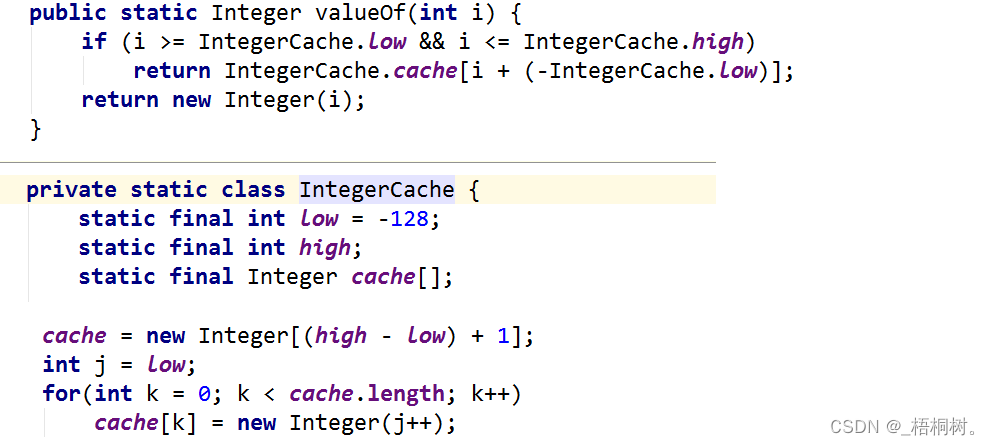
(3)intvalue():
Integer i1=new Integer(12);
int num= i1.intValue();//Integer--->int
System.out.println(num);
(4)parseInt:
int num=Integer.parseInt("1asdfasdf");//String--->int
(5)toString:
Integer i=new Integer(12);
System.out.println(i);
System.out.println(i.toString());//Integer---->String
String类
【1】属于java.lang包下,可以直接使用不需要导包
【2】

String str=“abc”;
(1)"abc"是靠三个字符组成:‘a’ ‘b’ ‘c’—>“abc”
(2)“abc”—>String类下的具体的一个对象。

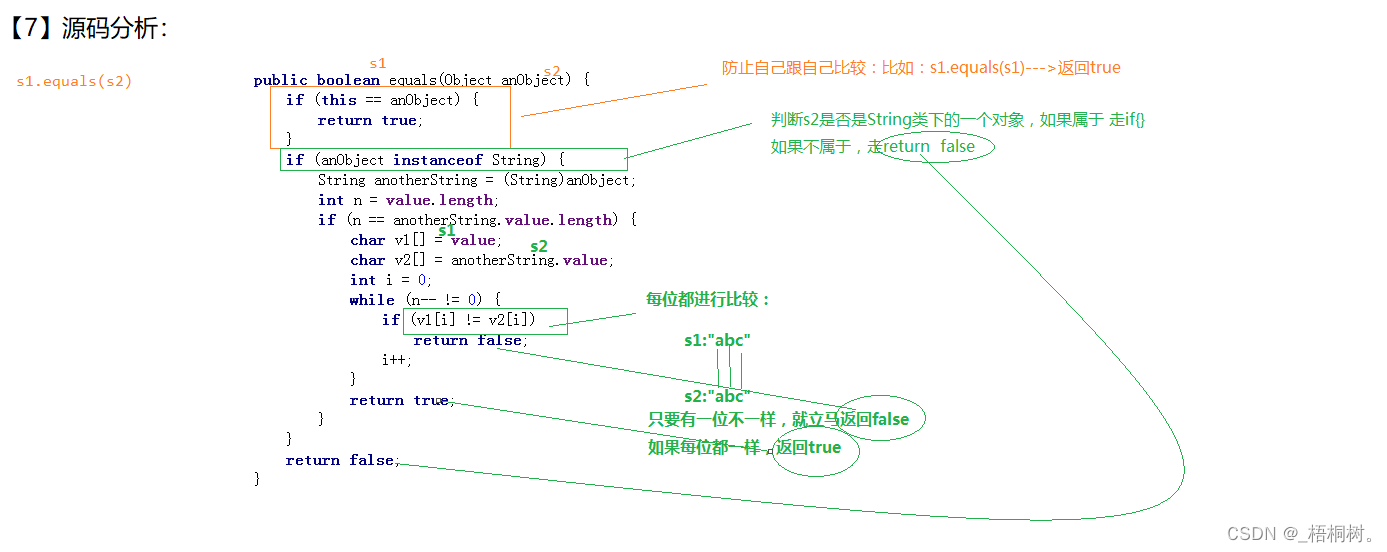
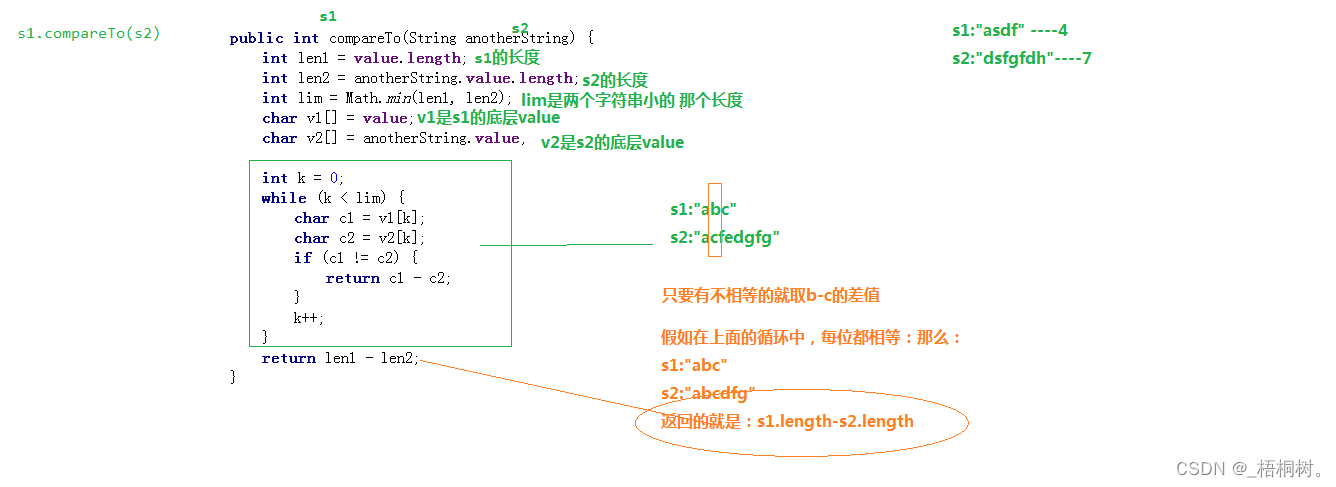
package com.bjsxt.test02;
import java.util.Arrays;
public class Test {
public static void main(String[] args) {
//字符串---》引用数据类型
// String str="你好java,\n2019!";
/*String s1=new String();
String s2=new String("abc");
System.out.println(s2);
String s3=new String(new char[]{'a','b','c'});
System.out.println(s3);*/
/*String s4="abcdef";
System.out.println(s4.length());//6
System.out.println(s4.isEmpty());
String s5="";
System.out.println(s5.isEmpty());
String s6=null;
System.out.println(s6.isEmpty());*///报错:NullPointerException
/*String s="asdfgj";
System.out.println(s.charAt(3));;//f*/
/* String s1=new String("aec");
String s2=new String("abc");
System.out.println(s1==s2);//false
System.out.println(s1.equals(s2));//比较内容的值是否相等
int num=s1.compareTo(s2);
System.out.println(num);*/
/* String s="abcdefghijk";
String newStr=s.substring(3);//字符串的截取:
System.out.println(newStr);
String ss=s.substring(3,7);//[3,7)的截取:
System.out.println(ss);*/
/*String a="abc";
String b="def";
String s=a.concat(b);//字符串的拼接
System.out.println(s);*/
/*String a="abcdaf";
String b=a.replace('a','j');
System.out.println(b);*/
/*String a="basdg";
System.out.println(a.contains("bas"));;*/
/*String a="a-b-c-d-e-f";
String[] str=a.split("-");
System.out.println(Arrays.toString(str));
String b="iahajaka";
String[] str2=b.split("a");
System.out.println(Arrays.toString(str2));*/
/* String a="abc";
System.out.println(a.toUpperCase().toLowerCase());;*/
/* String a="aaaa";
System.out.println(a.toString());*/
String a=" asds dsg df dg ";//去除首尾空格
System.out.println(a.trim());;
String s=String.valueOf(12);
System.out.println(s);
}
}
String字符串内存


总结:
(1)
“a”+“b”+“c”---->“abc”
“abc”+“”—>“abc”
这种给定的字符串,会进行编译器优化,直接拼成完整的字符串 。直接在方法区的常量池中开辟空间,然后地址给了栈中的变量,不会在堆中开辟空间。
(2)用new关键字创建对象:
就会在堆中开辟空间。
(3)有变量参与运算进行字符串拼接的时候,会在堆中开辟空间。
面试题:
public class Test {
public static void main(String[] args) {
String s4=new String("abc");
String s1="abc";
String s2="abc";
System.out.println(s1==s4);
System.out.println(s1==s2);
}
}
StringBuilder类
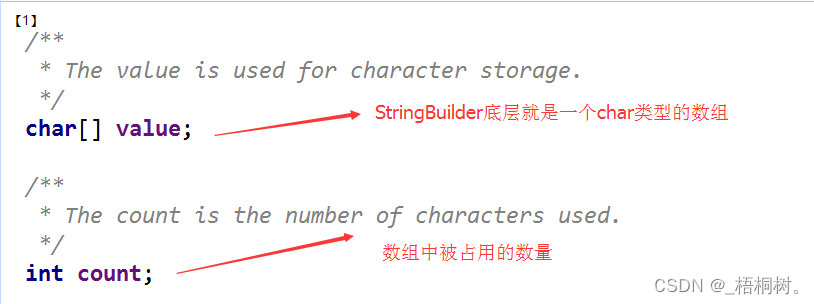
【2】
StringBuilder源码自行查看,然后自行画图:
public class Test {
public static void main(String[] args) {
String a="abc";//不可变字符串
StringBuilder sb2=new StringBuilder();//底层char类型数组长度为16
StringBuilder sb=new StringBuilder("abc");//可变字符串
sb.append("ttttttt");
sb.append("uuuuuuuuuuuu");
sb.append("aaaaaaaaaaaaaaaaaaaaaaaaaaa");
}
}
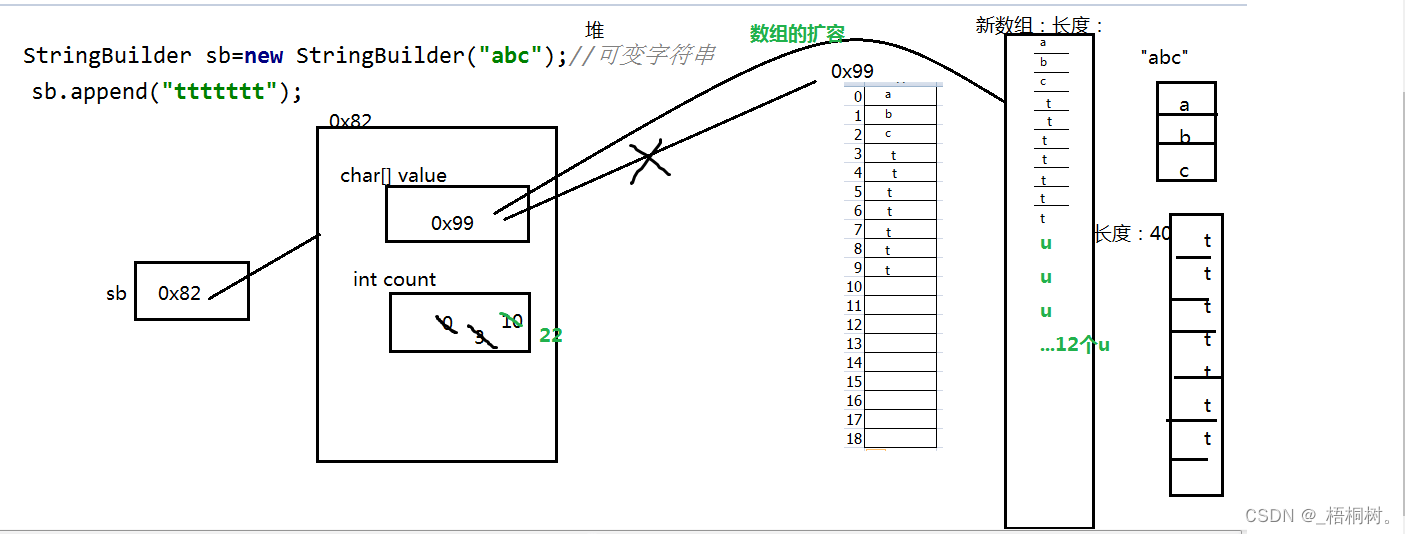
可变和不可变

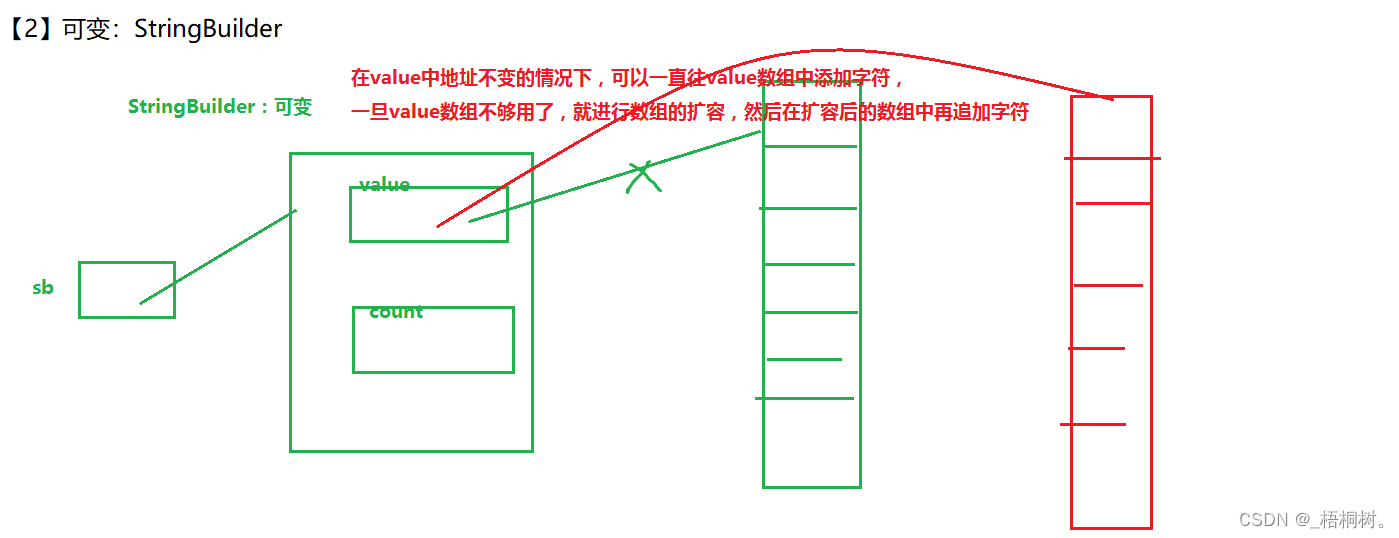
常见方法
public class Test {
public static void main(String[] args) {
StringBuilder sb=new StringBuilder("nihaojavawodeshijie");
//增
sb.append("这是梦想");
System.out.println(sb);//nihaojavawodeshijie这是梦想
//删
sb.delete(3, 6);//删除位置在[3,6)上的字符
System.out.println(sb);//nihavawodeshijie这是梦想
sb.deleteCharAt(16);//删除位置在16上的字符
System.out.println(sb);//nihavawodeshijie是梦想
//改
StringBuilder sb1=new StringBuilder("$23445980947");
sb1.insert(3, ",");//在下标为3的位置上插入 ,
System.out.println(sb1);
StringBuilder sb2=new StringBuilder("$2你好吗5980947");
sb2.replace(3, 5, "我好累");//在下标[3,5)位置上插入字符串
System.out.println(sb2);
sb.setCharAt(3, '!');
System.out.println(sb);
//查
StringBuilder sb3=new StringBuilder("asdfa");
for (int i = 0; i < sb3.length(); i++) {
System.out.print(sb3.charAt(i)+"\t");
}
System.out.println();
String str=sb3.substring(2,4);//截取[2,4)返回的是一个新的String,对StringBuilder没有影响
System.out.println(str);
System.out.println(sb3);
}
}
StringBuffer和StringBuilder区别
【1】StringBuiler:JDK1.5开始 效率高 线程不安全
【2】StringBuffer:JDK1.0开始 效率低 线程安全
联系:查看StringBuffer源码:底层依旧是数组的扩容。

时间处理的类
Date
package com.bjsxt.test01;
import java.util.Date;
public class Test {
public static void main(String[] args) {
//创建一个java.util.Date对象:
Date d=new Date();
System.out.println(d);
System.out.println(d.toString());
System.out.println(d.toGMTString());
//这个方法可以使用。但是这个方法过期了,过时了,废弃了。
System.out.println(d.toLocaleString());
System.out.println(d.getYear());//2019-1900=119
System.out.println(d.getMonth());//返回的值在 0 和 11 之间,值 0 表示 1 月。
System.out.println(d.getTime());//1556586936921
long time01=System.currentTimeMillis();
System.out.println(time01);
//问题:以后让你获取这个毫秒数,你优先用哪个方法?下面的。因为下面的方法被static修饰了,可以直接用类名.方法名直接调用,不用创建对象。
//创建java.sql.Date对象:
java.sql.Date date=new java.sql.Date(1556586936921L);
System.out.println(date);//2019-04-30
/*
(1)java.util.Date和java.sql.Date区别:
java.util.Date :年月日 时分秒
java.sql.Date :年月日
(2)java.util.Date和java.sql.Date联系:
Date 继承自java.util.Date
*/
//sql--->util:
Date d2=date;
//util--->sql:
java.sql.Date d3=(java.sql.Date)d2;
java.sql.Date d4=new java.sql.Date(new Date().getTime());
//sql.Date常用方法:String--->Date
java.sql.Date d5=java.sql.Date.valueOf("2019-3-8");
}
}
日期转换
【1】引入:
//String--->java.util.Date:
//1.String-->java.sql.Date
java.sql.Date d1=java.sql.Date.valueOf("2017/3/8");
//2.java.sql.Date--->java.util.Date
java.util.Date d2=d1;
System.out.println(d2);
//上面的valueOf方法,传入的字符串必须格式为:年-月-日 格式,这样就有限制了。

【3】两种最常用的方法:
public class Demo {
public static void main(String[] args) {
//日期格式化对象:
//DateFormat df=new DateFormat();抽象类不可以直接创建对象:
DateFormat df=new SimpleDateFormat("yyyy-MM-dd HH:mm:ss");
//String--->Date
try {
Date date=df.parse("2018-3-6 12:36:29");
System.out.println(date);
} catch (ParseException e) {
e.printStackTrace();
}
//Date--->String
String str=df.format(new Date());
System.out.println(str);
Date d2=new Date();
System.out.println(d2.toString());
System.out.println(d2.toLocaleString());
System.out.println(d2.toGMTString());
}
}
Calendar
Calendar这个类非常强大,关于日期的方法他都可以处理,但是
因为我们操作日期 基本就操作到年月日 时分秒,之前学的Date就已经够用了。
Calendar实际开发用的相对较少。
【1】基础代码:
package com.bjsxt.test03;
import java.util.Calendar;
import java.util.GregorianCalendar;
public class Test {
public static void main(String[] args) {
//Calendar是抽象类,不可以直接创建对象,可以用下面两种方法:
Calendar cal=new GregorianCalendar();
Calendar cal2=Calendar.getInstance();
System.out.println(cal.toString());
//日历类的常用属性读取:
System.out.println(cal.get(Calendar.YEAR));//2019
System.out.println(cal.get(Calendar.MONTH));//3---四月
System.out.println(cal.get(Calendar.DATE));//30
System.out.println(cal.get(Calendar.DAY_OF_WEEK));//3
System.out.println(cal.getActualMaximum(Calendar.DATE));
System.out.println(cal.getActualMinimum(Calendar.DATE));
//属性设置:
cal.set(Calendar.YEAR,2001);
cal.set(Calendar.MONTH,4);
cal.set(Calendar.DATE,10);
System.out.println(cal);
//String--->Calendar:
//String--->Date:
java.sql.Date d=java.sql.Date.valueOf("2019-3-5");
//Date--->Calendar:
cal.setTime(d);
System.out.println(cal);
}
}
【2】练习:

package com.bjsxt.test01;
import java.util.Calendar;
import java.util.Scanner;
public class Test {
public static void main(String[] args) {
//1.键盘录入提示信息:
/*Scanner sc=new Scanner(System.in);
System.out.print("请输入你想要查看的日期:(提示:请按照例如2019-3-7的格式)");
String strDate=sc.next();
System.out.println(strDate);*/
//2.将上面接收的String---》Calendar:
//2.1String--->Date
java.sql.Date d=java.sql.Date.valueOf("2019-1-24");
//2.2 Date---》Calendar:
Calendar cal= Calendar.getInstance();
cal.setTime(d);
//System.out.println(cal);
//3.输出日历的星期:
System.out.println("日\t一\t二\t三\t四\t五\t六\t");
//4.遍历 1-本月最大天 的数字:
//5.先求出本月最大天数:
int maxDay=cal.getActualMaximum(Calendar.DATE);
//System.out.println(maxDay);
//9.求出当天日期:
int nowDay=cal.get(Calendar.DATE);
//10.求出本月的第一天 是 一周中的第几天:
//10.1:将日期置成本月的第一天:
cal.set(Calendar.DATE,1);
int dayOfWeek= cal.get(Calendar.DAY_OF_WEEK);
//System.out.println("一号是本周第"+dayOfWeek+"天");
//11.求出一号前面的空格数:
int space=dayOfWeek-1;
//7.引入一个计数器,用来计算换行:(每7个一换行)
int count=space;
//12.遍历space:
for(int i=1;i<=space;i++){
System.out.print("\t");
}
//6.遍历:
for(int i=1;i<=maxDay;i++){
//8.在当天日期上加上*
if(i==nowDay){
System.out.print(i+"*\t");
}else{
System.out.print(i+"\t");
}
count++;
if(count%7==0){
System.out.println();
}
}
}
}
Math
【1】java.lang包下 不需要导包直接使用
【2】类被final修饰,不能被继承
【3】意味着在外面不能创建Math类的对象:
Math m=new Math();—不能

public class Demo {
public static void main(String[] args) {
System.out.println("随机数:"+Math.random());
System.out.println("绝对值:"+Math.abs(-30));
System.out.println("向上取值:"+Math.ceil(9.1));
System.out.println("向下取值:"+Math.floor(9.9));
System.out.println("四舍五入:"+Math.round(8.5));
System.out.println("最大值:"+Math.max(3,6));
System.out.println("最小值:"+Math.min(3,6));
System.out.println("次幂:"+Math.pow(3,6));
}
}
【6】静态导入:
可以将类名省略,然后import +static +那个包下那个类下的所有内容 (*) 。
假如在静态导入后,本类有同名方法,优先调用本类的方法。
package com.bjsxt.test01;
import static java.lang.Math.*;
public class Demo {
public static void main(String[] args) {
System.out.println("随机数:"+random());
System.out.println("绝对值:"+abs(-30));
System.out.println("向上取值:"+ceil(9.1));
System.out.println("向下取值:"+floor(9.9));
System.out.println("四舍五入:"+round(8.5));
System.out.println("最大值:"+max(3,6));
System.out.println("最小值:"+min(3,6));
System.out.println("次幂:"+pow(3,6));
}
public static int random(){
return 10;
}
}
【7】Random随机数类
Math.random()----->[0.0,1.0)
(1)利用有参构造器创建对象:
从结果发现,每次传入的参数(seed种子)只要是一样的,那么产生的结果也是一样的。
要想产生的随机数不一样,必须传入的种子就不一样。
public class TestRandom {
public static void main(String[] args) {
Random r=new Random(System.currentTimeMillis());
for (int i=1;i<=10;i++){
System.out.println(r.nextInt());
}
}
}
(2)利用空构造器创建对象:
表面上我们在用空构造器创建对象,实际上底层还是调用了有参构造器,
并且传入的参数每次创建对象都不一样:

public class TestRandom {
public static void main(String[] args) {
Random r=new Random();
for(int i=1;i<=10;i++){
//System.out.println(r.nextInt(10));
System.out.println(r.nextDouble());;
}
}
}

枚举类
【1】class—>类
interface—>接口
enum---->枚举 -----》全部都是引用数据类型
【2】引入:
public enum Gender {
男,女;
}
package com.bjsxt.test02;
public class Student {
//属性
private int age;
private String name;
private Gender sex;
//提供相应的setter,getter方法:
public int getAge() {
return age;
}
public void setAge(int age) {
this.age = age;
}
public String getName() {
return name;
}
public void setName(String name) {
this.name = name;
}
public Gender getSex() {
return sex;
}
public void setSex(Gender sex) {
this.sex = sex;
}
//构造器
public Student() {
}
public Student(int age, String name, Gender sex) {
this.age = age;
this.name = name;
this.sex = sex;
}
//toString:
@Override
public String toString() {
return "Student{" +
"age=" + age +
", name='" + name + '\'' +
", sex='" + sex + '\'' +
'}';
}
public static void main(String[] args) {
Student s=new Student();
s.setAge(19);
s.setName("lili");
s.setSex(Gender.女);
System.out.println(s);
Student s2=new Student(22,"feifei",Gender.女);
System.out.println(s2);
}
}
【3】总结:
只能够取特定值中的一个
使用enum关键字
所有的枚举类型隐性地继承自 java.lang.Enum。(枚举实质上还是类!而每个被枚举的成员实质就是一个枚举类型的实例,他们默认都是public static final的。可以直接通过枚举类型名直接使用它们。)
public enum Gender extends java.lang.Enum 隐性地继承自 java.lang.Enum
Gender继承自Enum类,Enum类继承自Object类,所以枚举类Gender也是一个类。
强烈建议当你需要定义一组常量时,使用枚举类型
尽量不要使用枚举的高级特性,事实上高级特性都可以使用普通类来实现,没有必要引入复杂性!
public enum Gender {
男,女;
/*public void show(){
System.out.println("assadf");
}*/
}
class Test{
public static void main(String[] args) {
//创建枚举类对象:
Gender a=Gender.女;
//a.show();
System.out.println(a);//Enum类中重写了toString
}
}
【4】枚举结合switch
package com.bjsxt.test02;
public class Demo {
public static void main(String[] args) {
/*
可以:int,byte,short,char,String,枚举类
不可以:long,float,double,boolean
*/
Gender a=Gender.女;
switch (a){
case 女:
System.out.println("是女");
break;
case 男:
System.out.println("是男");
break;
}
}
}
10、集合
数据结构
集合引入
【1】为什么使用集合?
举例:存储学生的成绩
以前:用数组 缺点:长度一旦确定就没有办法再修改了,所以如果删除或者增加元素,大量移动元素的位置。
特点:数组只能放一种数据类型,可以是基本数据类型也可以是引用数据类型
引入一个方法东西的-------》容器(集合)
优点:增加删除元素效率高
特点:一个集合可以方法多种数据类型,(但是一般我们都使用泛型,让他只放一种类型。)
但是它只可能放引用数据类型。
所以:集合能不能放int类型数据?不能。int类型可以进行自动装箱,转成包装类的Integer类型方放入集合。
【2】我们学习的集合,是各种各样的集合,为啥要学习不同的集合?
数据结构不一样,导致集合不一样,特点不一样。
【3】集合有哪些?简要结构图:

【4】集合的应用场景:
当需要将相同结构的个体整合到一起的时候,就考虑使用集合。

Collection接口
package com.bjsxt.test01;
import java.util.ArrayList;
import java.util.Collection;
import java.util.Iterator;
public class Test {
public static void main(String[] args) {
/*
接口常用方法:
增加:add(E e) addAll(Collection<? extends E> c)
删除:clear() remove(Object o)
修改:
查看:iterator() size()
判断:contains(Object o) equals(Object o) isEmpty()
*/
//Collection:接口不能创建对象:
Collection col=new ArrayList();
col.add(11);
col.add("aaaa");//表面上是int类型数据,实际12进行了自动装箱 然后我放入的是Integer数据
//Integer i=12; col.add(i);
col.add(33);//Double
Collection col2=new ArrayList();
col2.add(11);
col2.add(22);
col2.add(33);
//col.addAll(col2);
System.out.println(col.equals(col2));//true:证明底层一定重写了equals,比较的是具体的元素的值。
System.out.println(col==col2);//false:一定返回的是false,因为比较的是地址的值。
System.out.println("------------------");
col.remove("anc");
System.out.println(col/*.toString()*/);
System.out.println("集合中放的元素的个数:"+col.size());
System.out.println( col.contains(11));
/*col.clear();
System.out.println(col*//*.toString()*//*);
System.out.println("集合中放的元素的个数:"+col.size());
System.out.println(col.isEmpty());*/
System.out.println("-----------集合的遍历:-----------------");
//方法1:普通for循环:---不行:因为没有提供 根据索引获取元素的 方法
/*for(int i=0;i<=col.size()-1;i++){
System.out.println(col);
}*/
//方法2:增强for循环:
for(Object o:col){
System.out.print(o+"\t");
}
System.out.println("\n---------------------------------");
//方法3:iterator() 迭代器:
Iterator it= col.iterator();
while(it.hasNext()){
System.out.println(it.next());
}
}
}

第一个子接口List
package com.bjsxt.test01;
import java.util.ArrayList;
import java.util.Iterator;
import java.util.List;
public class Demo {
public static void main(String[] args) {
List list=new ArrayList();
/*
常用方法:
增加:add(int index, E element)
删除:remove(int index)
修改:set(int index, E element)
查看:get(int index)
判断:
*/
list.add(12);
list.add(82);
list.add(20);
list.add(38);
list.add(1);
list.add(1,666);
list.remove(1);
list.set(2,999);
System.out.println(list);
System.out.println(list.size());
System.out.println(list.get(3));
//对List集合的遍历:
//方式1:普通for循环:
System.out.print("[");
for(int i=0;i<=list.size()-1;i++){
if(i!=list.size()-1){
System.out.print(list.get(i)+", ");
}else{
System.out.print(list.get(i)+"]");
}
}
System.out.println("\n----------------------");
//方法2:增强for循环:
for(Object o:list){
System.out.println(o);
}
System.out.println("\n----------------------");
//方式3:迭代器:
Iterator it = list.iterator();
while(it.hasNext()){
System.out.println(it.next());
}
}
}
实现类:ArrayList
源码
总结:ArrayList底层就是数组,那些方法其实就是对数组进行增删改查操作。
【1】
public class Test2 {
public static void main(String[] args) {
//创建一个ArrayList对象:
ArrayList al=new ArrayList();//调用构造器,底层数组是{},长度为0
第一次调用add方法:
al.add("abc");
}
}
总结:调用空构造器和第一次add做了什么事?
首先将底层的数组扩容为长度为10 ,然后在长度为10的新数组中添加元素:
public class ArrayList{
//ArrayList底层是一个Object类型的数组
transient Object[] elementData;
//这个Object类型的数组被使用的数量。
private int size;
//就是一个空的Object的数组
private static final Object[] DEFAULTCAPACITY_EMPTY_ELEMENTDATA = {};
//空构造器:底层数组 长度0
public ArrayList() {
this.elementData = DEFAULTCAPACITY_EMPTY_ELEMENTDATA;
//赋予了一个{}数组---->this.elementData = {}
}
public boolean add(E e) {//实际参数:"abc"
ensureCapacityInternal(size + 1); // 经历了这个方法,底层已经将数组扩容为10了
elementData[size++] = e;//elementData[0]="abc" 然后size+1操作
return true;
}
private void ensureCapacityInternal(int minCapacity) {//1
ensureExplicitCapacity(calculateCapacity(elementData, minCapacity));
//ensureExplicitCapacity(10)
}
private static int calculateCapacity(Object[] elementData, int minCapacity) {//参数:{},1
// 现在elementData == DEFAULTCAPACITY_EMPTY_ELEMENTDATA满足,返回的是true,走这个if了
if (elementData == DEFAULTCAPACITY_EMPTY_ELEMENTDATA) {
//return Math.max(10,1);---->10
return Math.max(DEFAULT_CAPACITY, minCapacity);
}
return minCapacity;
}
private void ensureExplicitCapacity(int minCapacity) {//参数:10
modCount++;
// overflow-conscious code
if (minCapacity - elementData.length > 0)//10-0》0--》if是执行的
grow(minCapacity);//grow(10)
}
private void grow(int minCapacity) {//minCapacity:10
int oldCapacity = elementData.length;//oldCapacity:0
int newCapacity = oldCapacity + (oldCapacity >> 1);//newCapacity:0
if (newCapacity - minCapacity < 0)//if(0-10<0)-->这个分支走:
newCapacity = minCapacity;//newCapacity:10
if (newCapacity - MAX_ARRAY_SIZE > 0)//不走
newCapacity = hugeCapacity(minCapacity);//不走
//完成了数组的扩容,将原来的{}数组复制到长度为10的新数组中
//并且将ArrayList底层的老数组变成了长度为10的新数组。
elementData = Arrays.copyOf(elementData, newCapacity);
}
}
【2】
public class Test2 {
public static void main(String[] args) {
//创建一个ArrayList对象:
ArrayList al=new ArrayList();//调用构造器,底层数组是{},长度为0
第一次调用add方法:
al.add("abc");
al.add("ggg");
al.add("ggg");
al.add("ggg");
al.add("ggg");
al.add("ggg");
al.add("ggg");
al.add("ggg");
al.add("ggg");
al.add("ggg");
al.add("asdfasdfasdf");//放入第11个字符串:
}
}
public class ArrayList{
//ArrayList底层是一个Object类型的数组
transient Object[] elementData;
//这个Object类型的数组被使用的数量。
private int size;
//就是一个空的Object的数组
private static final Object[] DEFAULTCAPACITY_EMPTY_ELEMENTDATA = {};
public boolean add(E e) {//参数:"asdfasdfasdf"
ensureCapacityInternal(size + 1); // 经历完这个方法,底层数组已经扩容为新的长度为15的了
elementData[size++] = e;//elementData[10]="asdfasdfasdf" 然后进行size+1操作 size:11
return true;
}
private void ensureCapacityInternal(int minCapacity) {//11
//calculateCapacity(长度为10的老数组,11)
//ensureExplicitCapacity(11)
ensureExplicitCapacity(calculateCapacity(elementData, minCapacity));//
}
private static int calculateCapacity(Object[] elementData, int minCapacity) {
if (elementData == DEFAULTCAPACITY_EMPTY_ELEMENTDATA) {//分支不走
return Math.max(DEFAULT_CAPACITY, minCapacity);
}
return minCapacity;//走这个返回11
}
private void ensureExplicitCapacity(int minCapacity) {//11
modCount++;
// overflow-conscious code
if (minCapacity - elementData.length > 0)//11-10>0--->走
grow(minCapacity);//grow(11)
}
private void grow(int minCapacity) {//minCapacity:11
int oldCapacity = elementData.length;//oldCapacity:10
int newCapacity = oldCapacity + (oldCapacity >> 1);//newCapacity:15 :扩容长度是原来的1.5倍
if (newCapacity - minCapacity < 0)//不走
newCapacity = minCapacity;//不走
if (newCapacity - MAX_ARRAY_SIZE > 0)//不走
newCapacity = hugeCapacity(minCapacity);//不走
//底层老的数组 从长度为10变成了长度为15
//并且ArrayList底层数组的指向 指向了新的长度为15的数组
elementData = Arrays.copyOf(elementData, newCapacity);
}
}
【3】al.isEmpty();
【4】al.clear();
public void clear() {
modCount++;
for (int i = 0; i < size; i++)//对数组进行遍历
elementData[i] = null;//数组中的每个位置都置为null
size = 0;//数组中被占用的数量size置为0
}
【5】al.remove(“abc”);
public boolean remove(Object o) {//参数:“abc”
if (o == null) {//不走
for (int index = 0; index < size; index++)
if (elementData[index] == null) {
fastRemove(index);
return true;
}
} else {//走这个
for (int index = 0; index < size; index++)//对数组进行遍历
if (o.equals(elementData[index])) {//找数组中有没有元素"abc"
//假如找到了才走下面的方法
//fastRemove:删除这个元素了
//fastRemove(这个元素对应的索引)
fastRemove(index);//fastRemove(0)
return true;
}
}
return false;
}
private void fastRemove(int index) {//0
modCount++;
int numMoved = size - index - 1;//numMoved:5
if (numMoved > 0)//走这个分支
//System.arraycopy(elementData,1,elementData,0,5)---》底层通过数组的复制完成了删除操作
System.arraycopy(elementData, index+1, elementData, index,
numMoved);
elementData[--size] = null; //将数组中有效位置最后一个置为null
}
【6】al.get(3);
public E get(int index) {//3
rangeCheck(index);
return elementData(index);//elementData(3)
}
E elementData(int index) {
return (E) elementData[index];//elementData[3]
}
自己模拟一个ArrayList
package com.bjsxt.test02;
import java.util.Arrays;
public class MyArrayList {
//MyArrayList底层也是一个Object类型的数组:
Object[] value;
//数组中被使用的数量:
int count;
//空构造器:
public MyArrayList(){
//value=new Object[10];
this(10);
}
//有参构造器:
public MyArrayList(int length){
value=new Object[length];
}
//添加add方法:
public void add(Object o){
value[count]=o;
count++;
//进行数组的扩容:
if(count>value.length-1){//长度不够
//扩容方式1:Object[] newObj= Arrays.copyOf(value,20);
//扩容方式2:有新数组:
Object[] newObj=new Object[value.length*2+1];//10*2+1==21
//将老数组中的东西 复制 到新数组中:
for(int i=0;i<=value.length-1;i++){
newObj[i]=value[i];
}
//将value的指向:指向新的数组:
value=newObj;
}
}
//重写toString
@Override
public String toString() {
StringBuilder sb=new StringBuilder();
sb.append("[");//拼接左面的[
for(int i=0;i<=count-1;i++){
sb.append(value[i]+",");//将数组遍历拼接
}
sb.setCharAt(sb.length()-1,']');//将sb字符串最后的,替换为]
return sb.toString();
}
//增加一个计算数组中元素数量的方法:
public int length(){
return count;
}
//判断是否为空:
public boolean isEmpty(){
return count==0;
}
public static void main(String[] args) {
//创建一个我自定义的数组的对象:
MyArrayList list=new MyArrayList();//底层数组长度为10
list.add("abc");
list.add("dddd");
list.add("fdffff");
list.add("fdffff");
list.add("fdffff");
list.add("fdffff");
list.add("fdffff");
list.add("fdffff");
list.add("fdffff");
list.add("fdffff");
list.add("dddddddddddddddd");
list.add("33333");
System.out.println(list);
System.out.println("集合中元素的数量:"+list.length());
System.out.println(list.isEmpty());
}
}
练习:
list.remove(“abc”);
思路:
(1)将后一位移到前一位
(2)

将自定义的引用数据类型存入ArrayList集合
【1】代码:
package com.bjsxt.test03;
import java.util.ArrayList;
import java.util.Iterator;
public class Student {
//属性
private int age;
private String name;
//方法
public int getAge() {
return age;
}
public void setAge(int age) {
this.age = age;
}
public String getName() {
return name;
}
public void setName(String name) {
this.name = name;
}
//构造器
public Student(int age, String name) {
this.age = age;
this.name = name;
}
//main方法:
public static void main(String[] args) {
//创建一个ArrayList集合对象:
ArrayList al=new ArrayList();
Student s=new Student(19,"feifei");
al.add(s);
al.add(new Student(21,"lulu"));//匿名对象存入集合
al.add(new Student(22,"lili"));
//遍历:
//普通for
//增强for
//迭代器:
Iterator it = al.iterator();
while(it.hasNext()){
Student o=(Student)(it.next());
System.out.println(o.getName()+"----"+o.getAge());
}
}
}
【2】代码尝试改动:
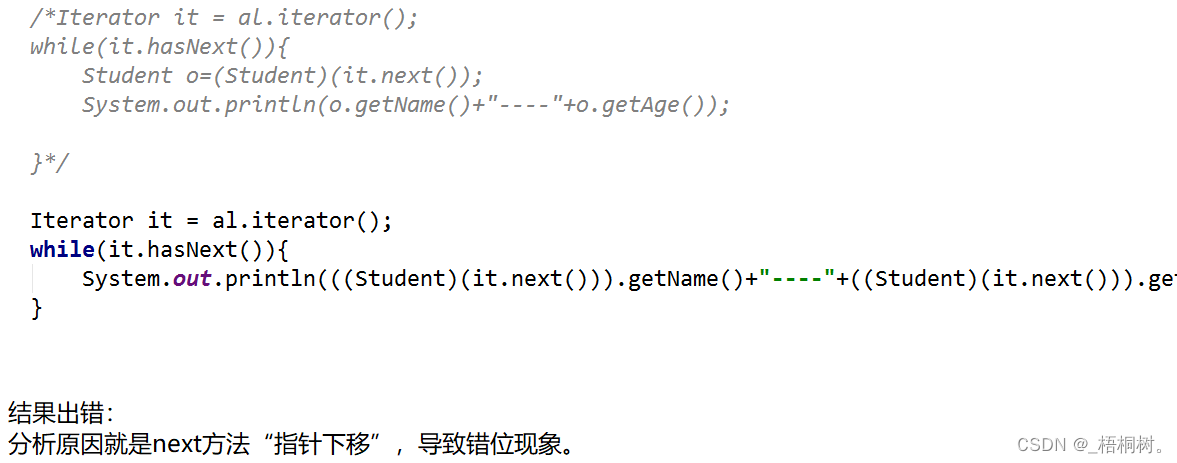
实现类:Vector
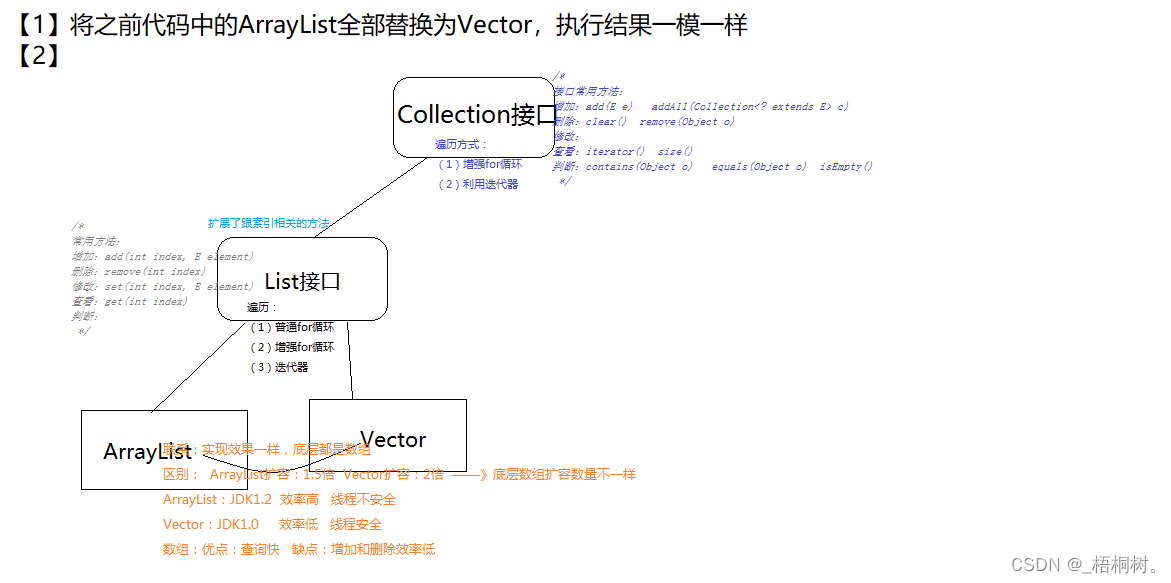
泛型
基本应用
package com.bjsxt.test03;
import java.util.ArrayList;
import java.util.Iterator;
public class Student {
//属性
private int age;
private String name;
//方法
public int getAge() {
return age;
}
public void setAge(int age) {
this.age = age;
}
public String getName() {
return name;
}
public void setName(String name) {
this.name = name;
}
@Override
public String toString() {
return "Student{" +
"age=" + age +
", name='" + name + '\'' +
'}';
}
//构造器
public Student(int age, String name) {
this.age = age;
this.name = name;
}
//main方法:
public static void main(String[] args) {
//创建一个ArrayList集合对象:
//加入泛型:作用:限制放入集合中元素的类型的,将类型限制为同一种类型
//加入泛型,其实就是对编译期间生效,在编译期间就不允许我添加其他的类型了!泛型在JDK1.5之后出的
ArrayList<Student> al=new ArrayList<Student>();
al.add(new Student(21,"lulu"));
al.add(new Student(22,"lulu2"));
al.add(new Student(23,"lulu3"));
/*al.add("abc");
al.add(12);
al.add(8.3);*/
//增强for遍历:
/*for(Object o:al){//Object o=学生对象
System.out.println(o);
}*/
//加了泛型之后,遍历更加简单了,直接用泛型类型接收即可
for(Student s:al){
System.out.println(s);
}
}
}
扩展:
就是为了让你能看懂API:
不是为了让你自己写代码用的。
泛型类:
package com.bjsxt.test04;
public class FanXing<AA> {
//FanXing其实就是一个普通的类,然后我加了<A>之后就变成了一个泛型类
//<>中的字母可以是什么?随意,但是在API中一般叫E
//<AA>就好像是一个占位符,就是告诉别人这里加了泛型,但是这个类型是什么还不确定
//什么时候确定呢?创建对象的时候才确定
}
class A{
public static void main(String[] args) {
//创建一个普通类的对象:
FanXing fx=new FanXing();
//加上泛型:
FanXing<Integer> fx2=new FanXing<Integer>();
FanXing<String> fx3=new FanXing<String>();
}
}
泛型方法:
package com.bjsxt.test04;
public class FanXing<AA> {
//普通方法:可以
public void a(){}
//方法的参数是AA,AA的类型确定吗?确定,AA在创建对象的时候就已经确定了
public void b(AA a){}
//方法的参数是BB,BB的类型确定吗?BB类型不确定
//帮我们解决了 不同数据类型做参数的重载问题
public <BB> void c(BB b){}
//static修饰的方法,先于对象存在
//先于对象存在,不知道AA是啥,因为AA的类型要在对象创建后才确定的
//public static void d(AA a){}
//BB无论有没有对象,BB的类型都不确定,所以加static无所谓
public static <BB> void e(BB b){}
public void f(AA[] a){}
public <QQ> QQ[] g(QQ...q){
//参数为可变参数,内部当做数组处理:
for(QQ a:q){
System.out.println(a);
}
return q;
}
}
class A{
public static void main(String[] args) {
//创建一个对象:
FanXing<Integer> fx=new FanXing<Integer>();
//AA的类型确定为Integer
fx.b(12);
fx.c(12);
fx.c("asdf");
fx.c(8.9);
fx.f(new Integer[]{12,34,43});
fx.g();
fx.g(12,23,45,45);
fx.g("asfd","asf","asfasdf");
}
}
泛型接口:
public interface MyInterface<AA> {
}
class A implements MyInterface {}
class B implements MyInterface<String> {
}
class C<BB> implements MyInterface<BB>{
public void a(BB b){}
}
泛型受限:
泛型的上限: ? extends A :只要泛型为A或者A的子类都可以传入
泛型的下限: ? super A :只要泛型为A或者A的父类都可以传入
package com.bjsxt.test06;
import java.util.ArrayList;
public class Person {
int age;
public Person(int age) {
this.age = age;
}
public Person() {
}
@Override
public String toString() {
return "Person{" +
"age=" + age +
'}';
}
}
class Student extends Person{
String name;
public Student(int age, String name) {
super(age);
this.name = name;
}
public Student(String name) {
this.name = name;
}
@Override
public String toString() {
return "Student{" +
"name='" + name + '\'' +
'}';
}
}
class Test{
public static void main(String[] args) {
//创建多个Person对象:将对象放入集合中:
ArrayList<Person> al=new ArrayList<Person>();
al.add(new Person(18));
al.add(new Person(20));
al.add(new Person(14));
show(al);
ArrayList<Student> al2=new ArrayList<Student>();
al2.add(new Student("nana"));
al2.add(new Student("feifei"));
al2.add(new Student("lili"));
show(al2);
}
//泛型受限:泛型的上限:只要是Person或者Person的子类 都可以传入
public static void show(ArrayList<? extends Person> al){
//对集合进行遍历:
for(Person p:al){
System.out.println(p);
}
//System.out.println("aaaa");
}
/*public static void show(ArrayList<Student> al2){
for(Student s:al2){
System.out.println(s);
}
}*/
}
实现类:LinkedList
基本代码
【1】基本代码:
package com.bjsxt.test07;
import java.util.LinkedList;
public class Test {
/*
LinkedList常用方法:
增加:addFirst(E e) addLast(E e)
offerFirst(E e) offerLast(E e)
删除:pollFirst() pollLast()--->JDK1.6 处理异常的方式更加健壮。
removeFirst() removeLast()--->JDK1.2
修改:
查看:getFirst() getLast()
peekFirst() peekLast()
判断:
*/
public static void main(String[] args) {
LinkedList<String> list=new LinkedList<String>();
list.add("aaa");
list.add("bbb");
list.add("ccc");
list.add("eee");
list.add("ffff");
System.out.println(list);
list.clear();
list.pollFirst();
list.pollLast();
/* System.out.println(list);*/
/*list.removeFirst();
list.removeLast();*/
/* System.out.println(list);*/
}
}
【2】底层结构:
public class Test {
public static void main(String[] args) {
LinkedList<String> list=new LinkedList<String>();
list.add("aaa");
list.add("bbb");
list.add("ccc");
}
}

【3】遍历:
public class Test {
public static void main(String[] args) {
LinkedList<String> list=new LinkedList<String>();
list.add("aaa");
list.add("bbb");
list.add("ccc");
list.add("eee");
list.add("ffff");
//遍历:
//普通for循环:
for(int i=0;i<=list.size()-1;i++){
System.out.println(list.get(i));
}
//增强for:
for(String s:list){
System.out.println(s);
}
//迭代器:
//理解简单
/*Iterator<String> it = list.iterator();
while(it.hasNext()){
System.out.println(it.next());
}*/
System.out.println("-----------");
//虽然难理解,但是这个好:
for(Iterator<String> it = list.iterator();it.hasNext();){
System.out.println(it.next());
}
}
}
扩展
添加链接描述
模拟LinkedList
【1】add方法模拟:
package com.bjsxt.test08;
public class Node {//结点类
//定义属性:
private Object pre;//结点的前一个元素的指向
private Object obj;//结点当前的元素
private Object next;//结点的后一个元素的指向
//提供setget方法:
public Object getPre() {
return pre;
}
public void setPre(Object pre) {
this.pre = pre;
}
public Object getObj() {
return obj;
}
public void setObj(Object obj) {
this.obj = obj;
}
public Object getNext() {
return next;
}
public void setNext(Object next) {
this.next = next;
}
@Override
public String toString() {
return ""+obj;
}
}
package com.bjsxt.test08;
public class MyLinkedList {
//这个链表中一定有一个头结点
Node first;
//这个链表中一定有一个尾结点
Node last;
//计数器:
int count=0;
public MyLinkedList(){}
//添加元素:
public void add(Object o){
//如果你放入的是第一个元素:
if(first==null){
//创建一个结点的对象:
Node n=new Node();
n.setPre(null);
n.setObj(o);
n.setNext(null);
//将这个链表的first和last都指向这个新的结点:
first=n;
last=n;
}else{//第二个结点以后都走这个分支:
//创建一个结点的对象:
Node n=new Node();
n.setPre(last);//放入当前链表中的last结点
n.setObj(o);
n.setNext(null);
//在将链表中的最后一个结点的next指向 新创建的结点
last.setNext(n);
//将链表的最后一个结点变成我新创建的结点
last=n;
}
count++;
}
public Object get(int index){
Node n=first;
for(int i=0;i<index;i++){
n=(Node)(n.getNext());
}
return n.getObj();
}
public static void main(String[] args) {
//创建我自定义的链表集合的对象:
MyLinkedList ml=new MyLinkedList();
ml.add("aaa");
ml.add("bbb");
ml.add("ccc");
System.out.println(ml.count);
System.out.println(ml.get(2));;//通过索引得到元素
}
}

【2】源码简单查看:
a.构造器:
public LinkedList() {
}
b.add第一个元素:
//假如放入的是第一个结点“aaa”-->first=null last=null
void linkLast(E e) {//"aaa"
final Node<E> l = last;//l:null
//将我放入的元素封装成为一个Node对象:利用构造器进行赋值:(null,"aaa",null)
final Node<E> newNode = new Node<>(l, e, null);
last = newNode;//将链中last指向新的结点newNode
if (l == null)//走
first = newNode;//将链中first指向新的结点newNode
else
l.next = newNode;
size++;//size计数器加1
modCount++;
}
c.add第2个元素:
//假如放入的是第2个结点“bbb”-->first="aaa" last="aaa"
void linkLast(E e) {//"bbb"
final Node<E> l = last;//l:"aaa"
//将我放入的元素封装成为一个Node对象:利用构造器进行赋值:("aaa","bbb",null)
final Node<E> newNode = new Node<>(l, e, null);
last = newNode;//将链中last指向新的结点newNode
if (l == null)//不走
first = newNode;
else//走
l.next = newNode;//将“aaa”的下一个指向newNode
size++;//size计数器再加1
modCount++;
}
d.clear()
public void clear() {
// Clearing all of the links between nodes is "unnecessary", but:
// - helps a generational GC if the discarded nodes inhabit
// more than one generation
// - is sure to free memory even if there is a reachable Iterator
for (Node<E> x = first; x != null; ) {
Node<E> next = x.next;
x.item = null;
x.next = null;
x.prev = null;
x = next;
}
first = last = null;
size = 0;
modCount++;
}
e.get(index)
size是链表的计数器,size/2将索引分为左右两部分,
如果是左面的部分:正序查找
如果是右面的部分:倒叙查找
*/
Node<E> node(int index) {
// assert isElementIndex(index);
if (index < (size >> 1)) {
Node<E> x = first;
for (int i = 0; i < index; i++)
x = x.next;
return x;
} else {
Node<E> x = last;
for (int i = size - 1; i > index; i--)
x = x.prev;
return x;
}
}
面试:iterator(),Iterator,Iterable关系

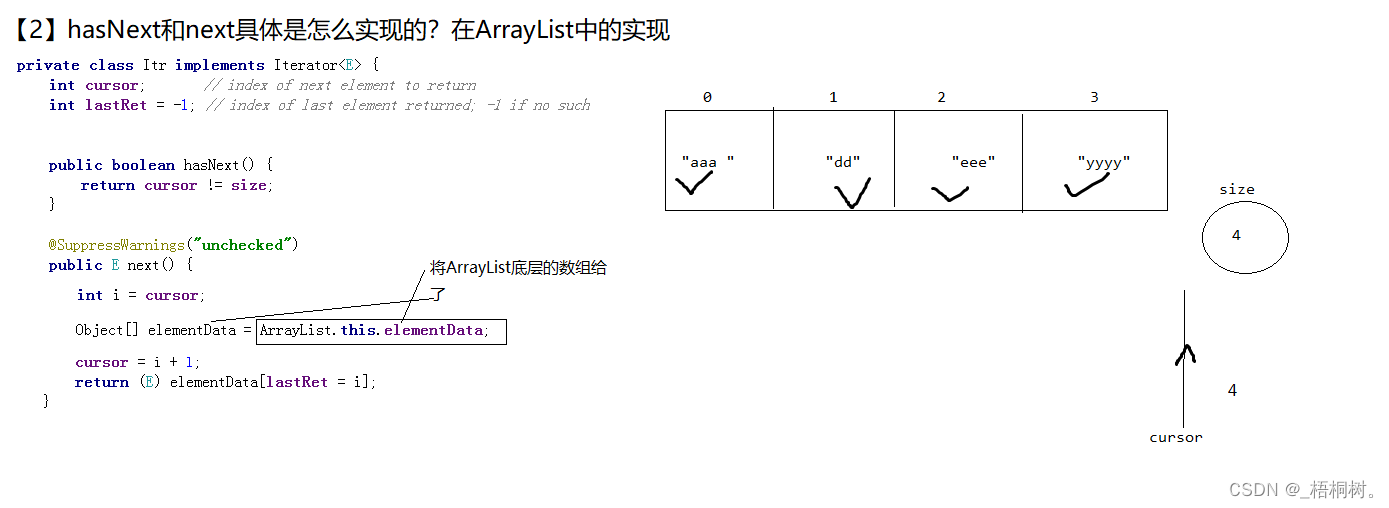
ListIterator
【1】在指定的字符串之后添加一个新的字符串:
public class Test {
public static void main(String[] args) {
ArrayList al=new ArrayList();
al.add("aaa");
al.add("bbb");
al.add("ccc");
al.add("ddd");
//在“ccc”之后添加一个字符串“eeeeee”:
Iterator it = al.iterator();
while(it.hasNext()){
if("ccc".equals(it.next())){
al.add("eeeeee");
}
}
}
}

public class Test {
public static void main(String[] args) {
ArrayList al=new ArrayList();
al.add("aaa");
al.add("bbb");
al.add("ccc");
al.add("ddd");
//在“ccc”之后添加一个字符串“eeeeee”:
ListIterator li = al.listIterator();
while(li.hasNext()){
if("ccc".equals(li.next())){
li.add("eeeee");
}
}
System.out.println(al);
}
}
可以进行倒序遍历:
public class Test {
public static void main(String[] args) {
ArrayList al=new ArrayList();
al.add("aaa");
al.add("bbb");
al.add("ccc");
al.add("ddd");
//在“ccc”之后添加一个字符串“eeeeee”:
ListIterator li = al.listIterator();
while(li.hasNext()){
if("ccc".equals(li.next())){
li.add("eeeee");
}
}
//System.out.println(li.hasNext());
//System.out.println(li.hasPrevious());
//倒着遍历:
while(li.hasPrevious()){
System.out.println(li.previous());
}
System.out.println(li.hasPrevious());
System.out.println(li.hasNext());
//System.out.println(al);
}
}
第二个子接口Set
HashSet
【1】放入Integer类型数据:
public class Test {
public static void main(String[] args) {
//创建一个Set集合:
Set set=new HashSet();
set.add(12);
System.out.println(set.add(26));//true--->放进去了返回true
set.add(6);
set.add(7);
System.out.println(set.add(26));//false--->没放进去返回的是false
set.add(1);
System.out.println(set);//特点:唯一,无序
System.out.println(set.size());//5
}
}
【2】放入String类型数据:
public class Test {
public static void main(String[] args) {
//创建一个Set集合:
Set set=new HashSet();
set.add("java");
System.out.println(set.add("html"));//true--->放进去了返回true
set.add("css");
set.add("jQuery");
System.out.println(set.add("html"));//false--->没放进去返回的是false
set.add("Mybatis");
System.out.println(set);//特点:唯一,无序
System.out.println(set.size());//5
}
}
【3】放入自定义的引用数据类型:
public class Test {
public static void main(String[] args) {
Set set=new HashSet();
set.add(new Student(18,"nana",180.4));
System.out.println(set.add(new Student(21,"feifei",160.4)));
set.add(new Student(27,"lili",150.4));
System.out.println( set.add(new Student(21,"feifei",160.4)));
set.add(new Student(16,"lulu",170.4));
System.out.println(set);
System.out.println(set.size());
}
}
public class Student {
private int age;
private String name;
private double height;
public int getAge() {
return age;
}
public void setAge(int age) {
this.age = age;
}
public String getName() {
return name;
}
public void setName(String name) {
this.name = name;
}
public double getHeight() {
return height;
}
public void setHeight(double height) {
this.height = height;
}
public Student(int age, String name, double height) {
this.age = age;
this.name = name;
this.height = height;
}
@Override
public String toString() {
return "Student{" +
"age=" + age +
", name='" + name + '\'' +
", height=" + height +
'}';
}
}

深入理解HashSet

2.哈希表是如何查找数据的,如何添加数据的
1.计算哈希 码(调用hashCode(),结果是一个int值,整数的哈希码取自身即可)
2.计算在哈希表中的存储位置 y=k(x)=x%11 x:哈希码 k(x) 函数 y:在哈希表中的存储位置
3.存入哈希表
情况1:一次添加成功
情况2:多次添加成功(出现了冲突,调用equals()和对应链表的元素进行比较,
比较到最后,结果都是false,创建新节点,存储数据,并加入链表末尾)
情况3:不添加(出现了冲突,调用equals()和对应链表的元素进行比较,
经过一次或者多次比较后,结果是true,表明重复,不添加)
结论1:哈希表添加数据快(3步即可,不考虑冲突)
结论2:唯一
结论2:无序3.哈希表是如何查询数据的
和添加数据的过程是相同的
情况1:一次找到 23 86 76
情况2:多次找到 67 56 78
情况3:找不到 100 200
结论1:哈希表查询数据快
4.hashCode和equals到底有什么神奇的作用
hashCode():计算哈希码,是一个整数,根据哈希码可以计算出数据在哈希表中的存储位置
equals():添加时出现了冲突,需要通过equals进行比较,判断是否相同
查询时也需要使用equals进行比较,判断是否相同
5.并且执行了几次?
hashCode是放入几个元素,就执行几次
equals:在相同位置放入元素的时候才会去比较。
6.各种类型数据的hashCode()返回的值是什么?
Integer:返回的就是value值


7.equals方法又是怎么比较的呢?
8.如何减少冲突
1)哈希表的长度和表中的记录数的比例–装填因子:
如果Hash表的空间远远大于最后实际存储的记录个数,则造成了很大的空间浪费,
如果选取小了的话,则容易造成冲突。
在实际情况中,一般需要根据最终记录存储个数和关键字的分布特点来确定Hash表的大小。
还有一种情况时可能事先不知道最终需要存储的记录个数,则需要动态维护Hash表的容量,此时可能需要重新计算Hash地址。
装填因子=表中的记录数/哈希表的长度, 4/ 16 =0.25 8/ 16 =0.5 12/16=0.75
如果装填因子越小,表明表中还有很多的空单元,则添加发生冲突的可能性越小;
而装填因子越大,则发生冲突的可能性就越大,在查找时所耗费的时间就越多。
有相关文献证明当装填因子在0.5左右的时候,Hash的性能能够达到最优。
因此,一般情况下,装填因子取经验值0.5。
2)哈希函数的选择
直接定址法 平方取中法 折叠法 除留取余法(y = x%11)
查询相关资料
3)链地址法(数组里面是链表)
当然还有其他的方法:开放地址法,再散列法,建立一个公共溢出区
复习
【1】hashCode()是做什么事的?
放入的类型要重写这个方法,然后返回一个int类型的数,–》哈希码
得到哈希码,根据一个表达式,算出在主数组中的位置。
【2】equals()是做什么事的?
当在相同位置放元素的时候,要先进行比较(只比较是否相等即可,不用比谁大谁小)
【3】底层的计算位置的表达式 真的是取余数那个吗?不一定
y=x%5–没有验证
【4】底层主数组长度是多少??–没有验证
【5】数组长度为16,但是我放了20个元素,现在冲突的概率是不是就大了
有没有处理办法???—》扩容 --没有验证
【6】主数组—》是什么类型的?–没有验证
【7】数组中的那个链表啥样的?结点啥样?–没有验证
【8】链表追加元素 请问在哪加?–没有验证
TreeSet
【1】放入Integer类型数据:
public class Test {
public static void main(String[] args) {
Set set=new TreeSet();
set.add(12);
System.out.println(set.add(3));;
set.add(7);
set.add(9);
System.out.println(set.add(3));;
set.add(16);
System.out.println(set);//有序:按照升序进行排列 无序:没有按照输入顺序进行输出
System.out.println(set.size());//5: 唯一
}
}
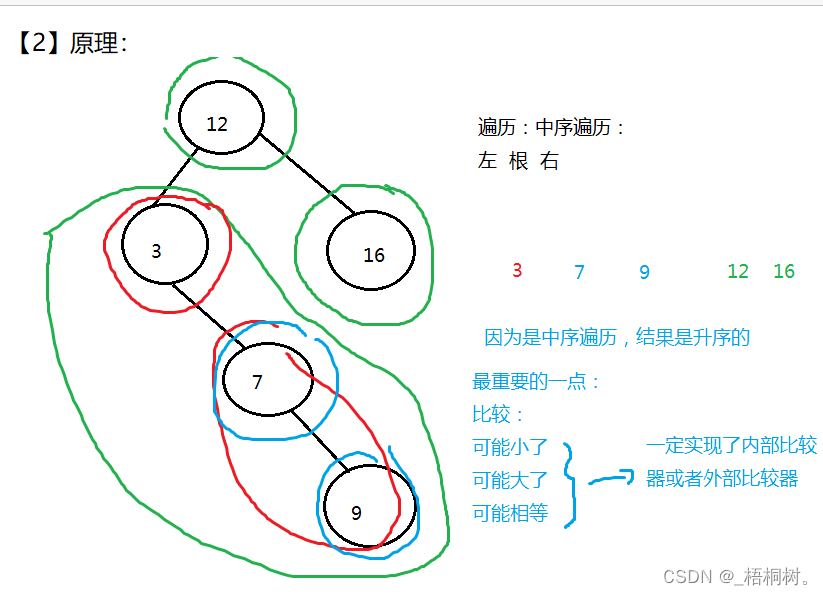
【3】验证Integer底层真的实现了内部比较器:

【4】放入String类型数据:
public class Test {
public static void main(String[] args) {
Set set=new TreeSet();
set.add("cjava");
System.out.println(set.add("ejava"));;
set.add("ajava");
set.add("djava");
System.out.println(set.add("ejava"));;
set.add("bjava");
System.out.println(set);//有序:按照升序进行排列 无序:没有按照输入顺序进行输出
System.out.println(set.size());//5: 唯一
}
}

【5】放入自定义的引用数据类型的数据:
必须实现内部比较器:
package com.bjsxt.test03;
public class Student implements Comparable {
@Override
public int compareTo(Object o) {
//比较规则:
//按照年龄排序:
Student other=(Student)o;
//return -(this.getAge()-other.getAge());
//按照身高比较:
//return ((Double)(this.getHeight())).compareTo((Double)(other.getHeight())) ;
//按照姓名比较:
//return this.getName().compareTo(other.getName());
//按照姓名和年龄比较。
if(this.getName().compareTo(other.getName())==0){//姓名相等了才比较年龄,
return this.getAge()-other.getAge();
}else{//姓名不等
return this.getName().compareTo(other.getName());
}
}
private String name;
private int age;
private double height;
public String getName() {
return name;
}
public void setName(String name) {
this.name = name;
}
public int getAge() {
return age;
}
public void setAge(int age) {
this.age = age;
}
public double getHeight() {
return height;
}
public void setHeight(double height) {
this.height = height;
}
public Student(String name, int age, double height) {
this.name = name;
this.age = age;
this.height = height;
}
@Override
public String toString() {
return "Student{" +
"name='" + name + '\'' +
", age=" + age +
", height=" + height +
'}';
}
}
package com.bjsxt.test03;
import java.util.Set;
import java.util.TreeSet;
public class Test {
public static void main(String[] args) {
Set set=new TreeSet();
set.add(new Student("alili",17,170.4));
set.add(new Student("blili",14,160.4));
set.add(new Student("alili",12,180.4));
set.add(new Student("clili",21,140.4));
set.add(new Student("alili",14,160.4));
set.add(new Student("elili",10,150.4));
System.out.println(set);
System.out.println(set.size());
}
}
利用外部比较器:
package com.bjsxt.test03;
import java.util.Comparator;
public class Student {
private String name;
private int age;
private double height;
public String getName() {
return name;
}
public void setName(String name) {
this.name = name;
}
public int getAge() {
return age;
}
public void setAge(int age) {
this.age = age;
}
public double getHeight() {
return height;
}
public void setHeight(double height) {
this.height = height;
}
public Student(String name, int age, double height) {
this.name = name;
this.age = age;
this.height = height;
}
@Override
public String toString() {
return "Student{" +
"name='" + name + '\'' +
", age=" + age +
", height=" + height +
'}';
}
}
class BiJiao01 implements Comparator{
@Override
public int compare(Object o1, Object o2) {
//规则:按照年龄比较:
Student s1=(Student)o1;
Student s2=(Student)o2;
return s1.getAge()-s2.getAge();
}
}
class BiJiao02 implements Comparator{
@Override
public int compare(Object o1, Object o2) {
//规则:按照姓名比较:
Student s1=(Student)o1;
Student s2=(Student)o2;
return s1.getName().compareTo(s2.getName());
}
}
package com.bjsxt.test03;
import java.util.Comparator;
import java.util.Set;
import java.util.TreeSet;
public class Test {
public static void main(String[] args) {
// BiJiao02 bj=new BiJiao02();
// Comparator bj=new BiJiao02();//多态
//将外部比较器跟TreeSet集合利用构造器进行关联。
//匿名内部类:如果这个比较规则 在项目中只用一次,就用匿名内部类写即可。
Set set=new TreeSet(new Comparator() {
@Override
public int compare(Object o1, Object o2) {
//规则:按照姓名比较:
Student s1=(Student)o1;
Student s2=(Student)o2;
return s1.getName().compareTo(s2.getName());
}
});
set.add(new Student("alili",17,170.4));
set.add(new Student("blili",14,160.4));
set.add(new Student("alili",12,180.4));
set.add(new Student("clili",21,140.4));
set.add(new Student("alili",14,160.4));
set.add(new Student("elili",10,150.4));
System.out.println(set);
System.out.println(set.size());
}
}
总结:
底层:二叉树
只要是放进去的自定义的引用数据类型,比较实现内部比较器或者外部比较器
完整结构图

Map接口
HashMap
【1】总结:
HashMap的特点是按照key来说的,无序,唯一
HashMap中提供了各种方法,对于查找的方法很全面:
对key遍历,对value遍历,对key-value的映射键值对 一起遍历的
package com.bjsxt.test01;
import java.util.Collection;
import java.util.HashMap;
import java.util.Map;
import java.util.Set;
public class Test {
/*
接口 Map<K,V>---:key,value “键值对”
增加:put(K key, V value)
删除:clear() remove(Object key)
修改:
查看:entrySet() get(Object key) keySet() values()
size()
判断:containsKey(Object key)
containsValue(Object value)
isEmpty()
*/
public static void main(String[] args) {
//创建一个Map集合的对象:
Map<Integer,String> map=new HashMap<Integer,String>();
map.put(16,"zhaoss");//存入的成对的信息,存入的键值对,都是有映射关系。
System.out.println( map.put(8,"lili"));//null---这个value把谁替换了
map.put(4,"nana");
System.out.println(map.put(6,"lulu"));//lili
map.put(2,"feifei");
System.out.println(map.put(8,"ganggang"));//lulu
// map.clear();
//map.remove(4);
/*System.out.println(map);
System.out.println(map.size());//特点:唯一,无序(按照key来总结的特点)
System.out.println(map.containsKey(4555));;
System.out.println(map.containsValue("lili"));
map.clear();
System.out.println(map.isEmpty());*/
//遍历:查看: get(Object key)
//keySet();对集合的key部分做遍历
System.out.println("------------");
Set<Integer> set = map.keySet();
for(Integer i:set){
System.out.println(i);
}
System.out.println("------------");
//values()对集合的value部分做遍历
Collection<String> col = map.values();
for(String s:col){
System.out.println(s);
}
System.out.println("------------");
for(Integer i:set){
System.out.println(map.get(i));
}
System.out.println("------------");
//entrySet()
//entrySet方法返回值为Set类型,有泛型,泛型为:Entry类型---》这个东西是Map接口的内部接口
//这个接口又有两个泛型<Integer, String>
Set<Map.Entry<Integer, String>> set1 = map.entrySet();
for(Map.Entry<Integer, String> m:set1){
System.out.println(m.getKey()+"-----"+m.getValue());
}
}
}
【2】将代码中的HashMap全部替换为Hashtable,发现结果一模一样
TreeMap
【1】内部比较器:
package com.bjsxt.test02;
import java.util.TreeMap;
public class Test {
public static void main(String[] args) {
TreeMap<Student,String> tm=new TreeMap<Student,String>();
Student s1=new Student("lili",18,160.4);
tm.put(s1,s1.getName());
Student s2=new Student("glili",16,160.4);
tm.put(s2,s2.getName());
Student s3=new Student("lasdf",18,160.4);
tm.put(s3,s3.getName());
Student s4=new Student("ttti",12,160.4);
tm.put(s4,s4.getName());
System.out.println(tm);
System.out.println(tm.size());
}
}
package com.bjsxt.test02;
public class Student implements Comparable {
private String name;
private int age;
private double height;
public String getName() {
return name;
}
public void setName(String name) {
this.name = name;
}
public int getAge() {
return age;
}
public void setAge(int age) {
this.age = age;
}
public double getHeight() {
return height;
}
public void setHeight(double height) {
this.height = height;
}
public Student(String name, int age, double height) {
this.name = name;
this.age = age;
this.height = height;
}
@Override
public String toString() {
return "Student{" +
"name='" + name + '\'' +
", age=" + age +
", height=" + height +
'}';
}
@Override
public int compareTo(Object o) {
Student other=(Student)o;
return this.getAge()-other.getAge();
}
}
【2】外部比较器:
package com.bjsxt.test02;
import java.util.Comparator;
import java.util.TreeMap;
public class Test {
public static void main(String[] args) {
TreeMap<Student,String> tm=new TreeMap<Student,String>(new Comparator<Student>() {
@Override
public int compare(Student o1, Student o2) {
Student s1=(Student)o1;
Student s2=(Student)o2;
return s1.getAge()-s2.getAge();
}
});
Student s1=new Student("lili",18,160.4);
tm.put(s1,s1.getName());
Student s2=new Student("glili",16,160.4);
tm.put(s2,s2.getName());
Student s3=new Student("lasdf",18,160.4);
tm.put(s3,s3.getName());
Student s4=new Student("ttti",12,160.4);
tm.put(s4,s4.getName());
System.out.println(tm);
System.out.println(tm.size());
}
}
package com.bjsxt.test02;
public class Student {
private String name;
private int age;
private double height;
public String getName() {
return name;
}
public void setName(String name) {
this.name = name;
}
public int getAge() {
return age;
}
public void setAge(int age) {
this.age = age;
}
public double getHeight() {
return height;
}
public void setHeight(double height) {
this.height = height;
}
public Student(String name, int age, double height) {
this.name = name;
this.age = age;
this.height = height;
}
@Override
public String toString() {
return "Student{" +
"name='" + name + '\'' +
", age=" + age +
", height=" + height +
'}';
}
}
Map结构图

源码
HashMap,HashSet
【1】看HashMap的空构造器,put方法,get方法:
HashMap<Integer,String> hm=new HashMap<Integer,String>();
public class HashMap<K,V>{//K:--->Integer V:--->String
//就是Hash表原理底层最重要的那个主数组:
//这个主数组是什么类型的:Entry
transient Entry<K,V>[] table;
static final int DEFAULT_INITIAL_CAPACITY = 16;//要赋给主数组:长度是16
static final float DEFAULT_LOAD_FACTOR = 0.75f;//装填因子
transient int size;//计数器:用来计数放入的元素的数量的
final float loadFactor;//一会用来接收装填因子的
int threshold;//用来接收 数组的最大承重 16*0.75=12
//发现Entry这个类是HashMap的一个内部类
static class Entry<K,V> implements Map.Entry<K,V> {
//4个属性:
final K key;//Integer key;---:键值对的“key”
V value;//String value---->键值对的“value”
Entry<K,V> next;//指向下一个结点
int hash;//哈希码
/**
* 构造器:创建Entry对象初始化
*/
Entry(int h, K k, V v, Entry<K,V> n) {
value = v;
next = n;
key = k;
hash = h;
}
}
//空构造器:
public HashMap() {
//调用了本类的带参构造器 this(16,0.75f);
this(DEFAULT_INITIAL_CAPACITY, DEFAULT_LOAD_FACTOR);//
}
public HashMap(int initialCapacity, float loadFactor) {//(16,0.75f)
int capacity = 1;
while (capacity < initialCapacity)
capacity <<= 1;
this.loadFactor = loadFactor;//loadFactor=0.75
threshold = (int)Math.min(capacity * loadFactor, MAXIMUM_CAPACITY + 1);
//threshold:12
table = new Entry[capacity];
//table = new Entry[16]--->主数组长度为16,创建了一个长度为16的主数组
useAltHashing = sun.misc.VM.isBooted() &&
(capacity >= Holder.ALTERNATIVE_HASHING_THRESHOLD);
init();
}
//hm.put(12,"aaa");
public V put(K key, V value) {K:--->Integer V:--->String
//对key是否为空的判断
if (key == null)
return putForNullKey(value);
//计算key的哈希码:底层进行了二次散列 :h ^= k.hashCode();为了避免哈希码重复
int hash = hash(key);
//计算key最在主数组的位置
//底层计算:h & (length-1) 其实他就相当于:h%(length-1)取余数
int i = indexFor(hash, table.length);// 假如人家算出来是:i=3
//1.假如放入的是第一个元素:table[3]是null 将table[3]给了e
//2.e=null --》不满足e!=null--->for循环不走
//9.再次往下标为3的位置上放东西:
//10table[3]-->0x99-->e : e--->0x99
//11. e!=null-->满足-->走入for循环中
for (Entry<K,V> e = table[i];
e != null;
e = e.next) {
Object k;
//12.底层调用equals进行比较。判断是否一样。
//如果一样,走入if
//如果不一样
if (e.hash == hash && ((k = e.key) == key || key.equals(k))) {
V oldValue = e.value;//将老的value给oldValue变量
e.value = value;//将老的value替换为新的value
e.recordAccess(this);
return oldValue;//将老的value返回,然后可以在控制台输出
}
}
//3.上面循环不走直接走下面的代码:
modCount++;
//4.addEntry(key的哈希码,key,value,元素的位置3)
//13.开始添加结点:
addEntry(hash, key, value, i);
return null;
}
//5.参数:(key的哈希码,key,value,元素的位置3)
void addEntry(int hash, K key, V value, int bucketIndex) {
//如果size的值大于12这个极限数字了,那么底层的主数组要扩容为原来的二倍
if ((size >= threshold) && (null != table[bucketIndex])) {
resize(2 * table.length);
hash = (null != key) ? hash(key) : 0;
bucketIndex = indexFor(hash, table.length);
}
createEntry(hash, key, value, bucketIndex);
}
//6.参数:(key的哈希码,key,value,元素的位置3)
void createEntry(int hash, K key, V value, int bucketIndex) {
//14.e:table[3]--->0x99
Entry<K,V> e = table[bucketIndex];//7.e:null
//8.table[3]=new Entry(key的哈希码,key,value,null)
//15.new Entry(哈希码,key,value,0x99)
table[bucketIndex] = new Entry<>(hash, key, value, e);
size++;
}
//16 new Entry(哈希码,key,value,0x99)
Entry(int h, K k, V v, Entry<K,V> n) {
value = v;//value=value
next = n;//next=null
key = k;//key=key
hash = h;//hash=哈希码
}
//通过key获取value
public V get(Object key) {
//判断key是否为null
if (key == null)
return getForNullKey();
Entry<K,V> entry = getEntry(key);
return null == entry ? null : entry.getValue();
}
}
在JDK1.7以前,插入元素是在链表的头插入
在JDK1.8以后,插入元素是在链表的尾部插入
在JDK。18以后,当链表的长度大于8的时候,底层变成了红黑树
【2】HashSet源码:
public class HashSet{
//底层:是一个Map:
private transient HashMap<E,Object> map;
//空构造器:构建Map
public HashSet() {
map = new HashMap<>();
}
public boolean add(E e) {
//给set添加元素其实底层就是给map put元素呢
//put将元素放入map的key位置 ,value位置放入的就是Object对象
return map.put(e, PRESENT)==null;
}
//就是一个Object对象
private static final Object PRESENT = new Object();
public Iterator<E> iterator() {
return map.keySet().iterator();
}
}
TreeMap,TreeSet
public class TreeMap{
private final Comparator<? super K> comparator;//comparator用来接收:外部比较器:
//空构造器:
public TreeMap() {
comparator = null;//没有指定外部比较器
}
//带参构造器
public TreeMap(Comparator<? super K> comparator) {
this.comparator = comparator;//指定外部比较器
}
private transient Entry<K,V> root = null;//初始化root为null
private transient int size = 0;//计算
public V put(K key, V value) {//添加元素
Entry<K,V> t = root;
//t=null意味着这个树中还没有结点呢
if (t == null) {
//比较:自己跟自己比
compare(key, key); // type (and possibly null) check
//
root = new Entry<>(key, value, null);
size = 1;
modCount++;
return null;
}
int cmp;
Entry<K,V> parent;
//将外部比较器给了cpr
Comparator<? super K> cpr = comparator;
//判断cpr是不是null
//不是空---》指定了外部比较器
if (cpr != null) {
do {
parent = t;
cmp = cpr.compare(key, t.key);
if (cmp < 0)
t = t.left;
else if (cmp > 0)
t = t.right;
else
return t.setValue(value);
} while (t != null);
}
//是空---》指定了内部比较器
else {
if (key == null)
throw new NullPointerException();
Comparable<? super K> k = (Comparable<? super K>) key;
do {
parent = t;
cmp = k.compareTo(t.key);
if (cmp < 0)
t = t.left;
else if (cmp > 0)
t = t.right;
else
return t.setValue(value);
} while (t != null);
}
Entry<K,V> e = new Entry<>(key, value, parent);
if (cmp < 0)
parent.left = e;
else
parent.right = e;
fixAfterInsertion(e);
size++;
modCount++;
return null;
}
}
验证红黑树
package com.bjsxt.test04;
import java.util.TreeMap;
public class Test {
public static void main(String[] args) {
TreeMap<Student,Integer> tm=new TreeMap<Student,Integer>();
tm.put(new Student(1),1001);
tm.put(new Student(2),1001);
tm.put(new Student(3),1001);
tm.put(new Student(4),1001);
tm.put(new Student(-5),1001);
}
}
package com.bjsxt.test04;
public class Student implements Comparable{
int age;
public Student(int age) {
this.age = age;
}
@Override
public String toString() {
return age+"";
}
@Override
public int compareTo(Object o) {
Student s=(Student)o;
System.out.println(this+"和"+s+"正在进行比较");
return this.age-s.age;
}
}
Collections工具类
package com.bjsxt.test007;
import java.util.ArrayList;
import java.util.Collections;
public class TestCollections {
public static void main(String[] args) {
ArrayList<String> al=new ArrayList<String>();
al.add("apple");
al.add("banana");
al.add("java");
System.out.println(al);
//addAll(Collection<? super T> c, T... elements)
Collections.addAll(al, "merry","lili","abc");
System.out.println(al);
Collections.addAll(al, new String[]{"nihao","jsp"});//可变参数相当于数组
System.out.println(al);
//binarySearch(List<? extends Comparable<? super T>> list, T key)
System.out.println(Collections.binarySearch(al, "lili"));//发现不准确 为什么?因为要对排序后的查找
Collections.sort(al);
System.out.println(al);
System.out.println(Collections.binarySearch(al, "abc"));//发现不准确 为什么?因为要对排序后的查找---返回索引
System.out.println(Collections.binarySearch(al, "aaaa"));//找不到 返回负数
//copy(List<? super T> dest, List<? extends T> src)
ArrayList<String> sl=new ArrayList<String>();
Collections.addAll(sl, "a","b","c","d","e","a","b","c","d","e");
System.out.println("==");
System.out.println(al);
System.out.println(sl);
Collections.copy(sl, al);//sl的长度必须大于al的长度的时候在可以进行赋值替换
System.out.println(al);
System.out.println(sl);//其实相当于替换
//fill(List<? super T> list, T obj)
System.out.println(al);
// Collections.fill(al, "java");
System.out.println(al);
//
System.out.println(Collections.max(al));;
}
}
11、IO流
File类
【1】盘符上:什么是文件,什么是文件夹?
有后缀的是:文件
没有后最的:文件夹(目录)
【2】文件,文件夹都可以存放在什么位置上?
C盘第一硬盘
【3】查看文件或者文件夹的属性


public class Test {
public static void main(String[] args) throws IOException {
//将程序和文件进行关联:创建File类的对象:
//File f=new File("d:\\a.txt");
File f=new File("d:/a.txt");
//File f=new File("d:"+File.separator+"a.txt");//与系统有关的默认名称分隔符
//常用方法:
System.out.println("文件是否可读:"+f.canRead());
System.out.println("文件是否可写:"+f.canWrite());
File f2=new File("d:/b.txt");
System.out.println("比较结果:"+f.compareTo(f2));//按字母顺序比较两个抽象路径名。
/*if(f.exists()){
System.out.println("是否删除成功:"+f.delete());
}else{
System.out.println("是否创建成功:"+f.createNewFile());//如果不存在,就创建,如果存在,不会重复创建
}*/
File f3=new File("d:/a.txt");
File f4=new File("d:/b.txt");
System.out.println("地址是否相等:"+(f3==f4));//false
System.out.println("路径是否相等:"+f3.equals(f4));
System.out.println("--------------------------------");
File f5=new File("a.txt");
if(f5.exists()){
System.out.println("是否删除成功:"+f5.delete());
}else{
System.out.println("是否创建成功:"+f5.createNewFile());//如果不存在,就创建,如果存在,不会重复创建
}
System.out.println("绝对路径:"+f5.getAbsolutePath());//在盘符上真正存放的位置
System.out.println("相对路径:"+f5.getPath());//相对谁而言?相对项目
System.out.println("toString得到的结果跟相对路径是一样的:"+f5);//toString
System.out.println("文件的名称:"+f.getName());
System.out.println("上级目录:"+f.getParent());
System.out.println("是否是一个目录:"+f.isDirectory());
System.out.println("是否是一个文件:"+f.isFile());
System.out.println("是否隐藏:"+f.isHidden());
System.out.println("文件中的字节数:"+f.length());
}
}
(2)File类对文件夹进行的操作:
public class Test2 {
public static void main(String[] args) throws IOException {
//关联:目录(文件夹)
File f=new File("d:/bjsxt");
//常用方法:
//f.mkdir();//创建单层目录
//f.mkdirs();//创建多层目录
//f.delete();//只能删除空文件夹
/*String[] str=f.list();//对文件夹下的文件或者目录进行遍历查看,得到的就是名字
for(String s:str){
System.out.println(s);
}*/
//用的多:
File[] files=f.listFiles();
for(File file:files){
System.out.println(file.length()+"--"+file.isDirectory()+"----"+file.getPath()+"---"+file.getName());
}
/*
System.out.println("文件是否可读:"+f.canRead());
System.out.println("文件是否可写:"+f.canWrite());
File f2=new File("d:/b.txt");
System.out.println("比较结果:"+f.compareTo(f2));//按字母顺序比较两个抽象路径名。*/
/*if(f.exists()){
System.out.println("是否删除成功:"+f.delete());
}else{
System.out.println("是否创建成功:"+f.createNewFile());//如果不存在,就创建,如果存在,不会重复创建
}*/
/* File f3=new File("d:/a.txt");
File f4=new File("d:/b.txt");
System.out.println("地址是否相等:"+(f3==f4));//false
System.out.println("路径是否相等:"+f3.equals(f4));
System.out.println("--------------------------------");
File f5=new File("a.txt");
if(f5.exists()){
System.out.println("是否删除成功:"+f5.delete());
}else{
System.out.println("是否创建成功:"+f5.createNewFile());//如果不存在,就创建,如果存在,不会重复创建
}
System.out.println("绝对路径:"+f5.getAbsolutePath());//在盘符上真正存放的位置
System.out.println("相对路径:"+f5.getPath());//相对谁而言?相对项目
System.out.println("toString得到的结果跟相对路径是一样的:"+f5);//toString
System.out.println("文件的名称:"+f.getName());
System.out.println("上级目录:"+f.getParent());
System.out.println("是否是一个目录:"+f.isDirectory());
System.out.println("是否是一个文件:"+f.isFile());
System.out.println("是否隐藏:"+f.isHidden());
System.out.println("文件中的字节数:"+f.length());*/
}
}
(3)习题:
遍历你某一个文件夹下的所有内容:
public class Test3 {
public static void main(String[] args) {
//遍历:d:/bjsxt目录下的所有内容:
showFile(new File("d:/bjsxt"),1);
}
//抽取:对目录进行遍历:
public static void showFile(File f,int level){
File[] files=f.listFiles();
for(File file:files){
//通过这个level在前面加点"-"
for(int i=0;i<level;i++){
System.out.print("- ");
}
if(file.isDirectory()){//是一个文件夹
System.out.println(file.getName());
//向下进行遍历查看:
showFile(file,level+1);
}else{//是文件:
System.out.println(file.getName());
}
}
}
}
public class Test3 {
public static void main(String[] args) {
//遍历:d:/bjsxt目录下的所有内容:
showFile(new File("d:/bjsxt"),1);
}
//抽取:对目录进行遍历:
public static void showFile(File f,int level){
File[] files=f.listFiles();
for(File file:files){
//通过这个level在前面加点"-"
for(int i=0;i<level;i++){
System.out.print("- ");
}
System.out.println(file.getName());
if(file.isDirectory()){//是一个文件夹
//向下进行遍历查看:
showFile(file,level+1);
}
}
}
}
IO的引入
【1】File类:关联盘符上面的文件或者文件夹:
做什么事:获取一些属性等信息,还可以对文件(目录)创建删除等操作。
但是:咱们有没有获取文件里面的东西?没有,因为File不能帮我们完成这个事
【2】IO能做的事:程序和数据源之间的桥梁:
分类:

【3】有哪些流:
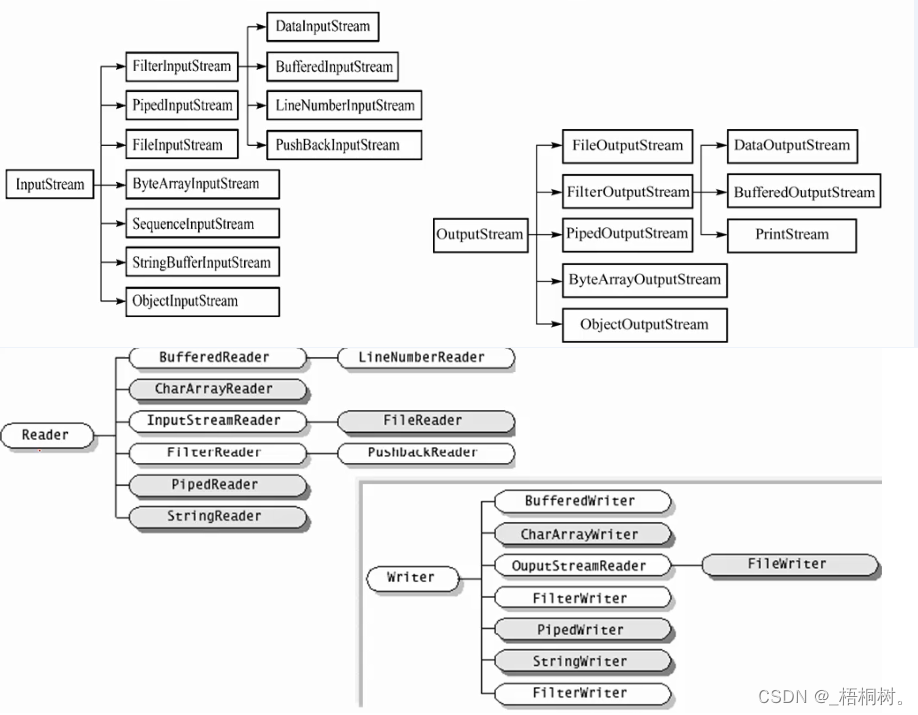
最终:文件的复制
分解:文件----》程序
FileInputStream
【1】利用字节流 :一个字节一个字节的读取数据:
public class Test {
public static void main(String[] args) throws IOException {
//1.有一个源文件:
File file=new File("d:\\bjsxt\\a.txt");
//2.将一根"管"搭在源文件和程序之间:---》IO流和文件进行关联:
FileInputStream fis=new FileInputStream(file);
//3.开始动作:"吸"---》读取:
/*int n=fis.read();
System.out.println(n);
int n2=fis.read();
System.out.println(n2);
int n3=fis.read();
System.out.println(n3);
int n4=fis.read();
System.out.println(n4);*/
int n=fis.read();//每次读一个字节进来
while(n!=-1){
System.out.println((char)n);
n=fis.read();
}
//4.关闭流:
fis.close();
}
}
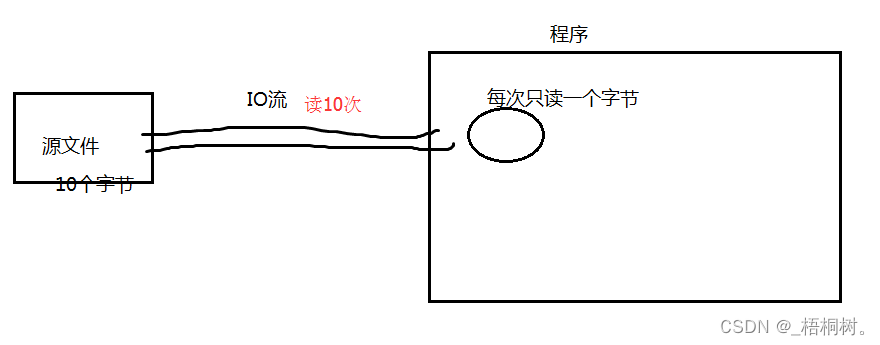
【2】提升效率的方式:利用缓冲数组:
在我这个题里面,我的缓冲数组长度定义为6,
实际在开发中一般定义为:1024的整数倍

public class Test {
public static void main(String[] args) throws IOException {
//1.有一个源文件:
File file=new File(“d:\bjsxt\a.txt”);
//2.将一根"管"搭在源文件和程序之间:—》IO流和文件进行关联:
FileInputStream fis=new FileInputStream(file);
//3.开始动作:“吸”—》读取:
//增加一个数组:
byte[] b=new byte[6];
/int len=fis.read(b);
int len2=fis.read(b);
int len3=fis.read(b);
System.out.println(len);//6
System.out.println(len2);//4
System.out.println(len3);//-1/
int len=fis.read(b);//每次数组中读取元素的数量;
while(len!=-1){
//System.out.println(len);
for(int i=0;i<=len-1;i++){
System.out.println((char)b[i]);
}
len=fis.read(b);
}
//4.关闭流:
fis.close();
}
}

分解:程序----》文件
FileOutputStream
【1】一个字节一个字节的向外传送数据:
public class Test {
public static void main(String[] args) throws IOException {
//1.确定目标文件:
File file=new File("d:/demo.txt");
//2.在文件和程序中间搭一根”管“
FileOutputStream fos=new FileOutputStream(file);
// FileOutputStream fos=new FileOutputStream(file,true);
//3.将内容写出去:
String str="abc123你好";
byte[] bytes=str.getBytes();
System.out.println("转换为数组的长度为:"+bytes.length);
for(byte b:bytes){
System.out.println(b);
fos.write(b);
}
//4.关闭流:
fos.close();
}
}
【2】利用数组向外传送数据:
public class Test2 {
public static void main(String[] args) throws IOException {
//1.确定目标文件:
File file=new File("d:/demo.txt");
//2.在文件和程序中间搭一根”管“
FileOutputStream fos=new FileOutputStream(file);
//3.将内容写出去:
String str="abc123你好asfdasfdasfdasdf";
byte[] bytes=str.getBytes();
fos.write(bytes);
//4.关闭流:
fos.close();
}
}
将上面两步骤合为一起:完成复制

public class Test {
public static void main(String[] args) throws IOException {
//1.有源文件:
File f1=new File("d:/a.txt");
//2.有目标文件:
File f2=new File("d:/b.txt");
//3.将一根管怼到源文件上去:
FileInputStream fis=new FileInputStream(f1);
//4.将一根管怼到目标文件上去:
FileOutputStream fos=new FileOutputStream(f2);
//5.开始动作:
int n=fis.read();
while(n!=-1){
fos.write(n);
n=fis.read();
}
//6.关闭流:
fos.close();
fis.close();
}
}

public class Test {
public static void main(String[] args) throws IOException {
//1.有源文件:
File f1=new File("d:/a.txt");
//2.有目标文件:
File f2=new File("d:/b.txt");
//3.将一根管怼到源文件上去:
FileInputStream fis=new FileInputStream(f1);
//4.将一根管怼到目标文件上去:
FileOutputStream fos=new FileOutputStream(f2);
//5.开始动作:
byte[] b=new byte[8];
int len=fis.read(b);
while(len!=-1){
fos.write(b,0,len);//将这个b数组中草[0,len)的位置弄出去--》其实就是将数组中的有效内容输出。
len=fis.read(b);
}
//6.关闭流:
fos.close();
fis.close();
}
}
编码总结
【1】在编辑器中:
utf-8:占用三个字节
bgk(ANSI):占用两个字节
【2】在java中:
无论是字母,数字,汉字等 全部内存都是占用一个字符。
节点流,处理流:BufferedInputStream,BufferedOutputStream
【1】利用FileInputStream,FileOutputStream 一个字节一个字节的读取写出数据:
public class Test {
public static void main(String[] args) throws IOException {
//1.有源文件:
File f1=new File("D:/JAVA_API_1.6_zh_CH.CHM");
//2.有目标文件:
File f2=new File("d:/b.CHM");
//3.将一根管怼到源文件上去:
FileInputStream fis=new FileInputStream(f1);
//4.将一根管怼到目标文件上去:
FileOutputStream fos=new FileOutputStream(f2);
long startTime=System.currentTimeMillis();
//5.开始动作:
int n=fis.read();
while(n!=-1){
fos.write(n);
n=fis.read();
}
//6.关闭流:
fos.close();
fis.close();
long endTime=System.currentTimeMillis();
System.out.println(endTime-startTime);
}
}
结果:需要的时间很长:
【2】利用FileInputStream,FileOutputStream 利用数组读取写出数据:
public class Test2 {
public static void main(String[] args) throws IOException {
//1.有源文件:
File f1=new File("D:/JAVA_API_1.6_zh_CH.CHM");
//2.有目标文件:
File f2=new File("d:/b.CHM");
//3.将一根管怼到源文件上去:
FileInputStream fis=new FileInputStream(f1);
//4.将一根管怼到目标文件上去:
FileOutputStream fos=new FileOutputStream(f2);
//5.开始动作:
long startTime=System.currentTimeMillis();
byte[] b=new byte[1024];
int len=fis.read(b);
while(len!=-1){
fos.write(b,0,len);//将这个b数组中草[0,len)的位置弄出去--》其实就是将数组中的有效内容输出。
len=fis.read(b);
}
//6.关闭流:
fos.close();
fis.close();
long endTime=System.currentTimeMillis();
System.out.println(endTime-startTime);
}
}
【3】用一种效率更高的方式:

package com.bjsxt.test03;
import java.io.*;
public class Test2 {
public static void main(String[] args) throws IOException {
//1.有源文件:
File f1=new File("D:/JAVA_API_1.6_zh_CH.CHM");
//2.有目标文件:
File f2=new File("d:/b.CHM");
//3.将一根管怼到源文件上去:
FileInputStream fis=new FileInputStream(f1);
//4.将一根管怼到目标文件上去:
FileOutputStream fos=new FileOutputStream(f2);
//5.在FileInputStream外再套一个管--》提升功能
BufferedInputStream bis=new BufferedInputStream(fis);//底层缓冲数组默认的大小为8192
//6.在FileOutputStream外再套一个管--》提升功能
BufferedOutputStream bos=new BufferedOutputStream(fos);
//7.开始动作:
long startTime=System.currentTimeMillis();
byte[] b=new byte[1024];
int len=bis.read(b);
while(len!=-1){
bos.write(b,0,len);
len=bis.read(b);
}
//6.关闭流://我们关闭流,倒着关闭:
/*bos.close();
bis.close();
fos.close();
fis.close();*/
//closeAll(bos,bis,fos,fis);
closeAll(bos,bis);//直接关闭最高级的流就可以了,可以省略里面那些流
long endTime=System.currentTimeMillis();
System.out.println(endTime-startTime);
}
public static void closeAll(Closeable...clos){
for(Closeable cl:clos){
try {
cl.close();
} catch (IOException e) {
e.printStackTrace();
}
}
}
}
字符流:FileReader,FileWriter:文件的复制
【1】利用FileReader,FileWriter 一个字符一个字符的 复制 数据:
public class Test {
public static void main(String[] args) throws IOException {
//1.源文件:
File f1=new File("d:/a.txt");
//2.目标文件:
File f2=new File("d:/b.txt");
//3.套管:
FileReader fr=new FileReader(f1);
FileWriter fw=new FileWriter(f2);
//4.开始动作:
int n=fr.read();
while(n!=-1){
System.out.println(n);
fw.write(n);
n=fr.read();
}
//5.关闭流:字符流有缓存机制,
fw.close();
fr.close();
//fw.flush();//冲刷
}
}
备注:以后不记得哪些流需要关闭,所以我们以后遇到流就管就行了。
【2】利用FileReader,FileWriter 利用字符数组:
public class Test {
public static void main(String[] args) throws IOException {
//1.源文件:
File f1=new File("d:/a.txt");
//2.目标文件:
File f2=new File("d:/b.txt");
//3.套管:
FileReader fr=new FileReader(f1);
FileWriter fw=new FileWriter(f2);
//4.开始动作:
char[] ch=new char[5];
int len=fr.read(ch);
while(len!=-1){
fw.write(ch,0,len);
len=fr.read(ch);
}
//5.关闭流:字符流有缓存机制,
fw.close();
fr.close();
//fw.flush();//冲刷
}
}
【3】利用缓冲流::
public class Test {
public static void main(String[] args) throws IOException {
//1.源文件:
File f1=new File("d:/a.txt");
//2.目标文件:
File f2=new File("d:/b.txt");
//3.套管:
FileReader fr=new FileReader(f1);
FileWriter fw=new FileWriter(f2);
BufferedReader br=new BufferedReader(fr);
BufferedWriter bw=new BufferedWriter(fw);
//4.开始动作:
char[] ch=new char[5];
int len=br.read(ch);
while(len!=-1){
bw.write(ch,0,len);
len=br.read(ch);
}
//5.关闭流:字符流有缓存机制,
bw.close();
br.close();
}
}
【4】缓冲流另一种方式:
public class Test {
public static void main(String[] args) throws IOException {
//1.源文件:
File f1=new File("d:/a.txt");
//2.目标文件:
File f2=new File("d:/b.txt");
//3.套管:
FileReader fr=new FileReader(f1);
FileWriter fw=new FileWriter(f2);
BufferedReader br=new BufferedReader(fr);
BufferedWriter bw=new BufferedWriter(fw);
//4.开始动作:
String str=br.readLine();
while(str!=null){
bw.write(str);
bw.newLine();
str=br.readLine();
}
//5.关闭流:字符流有缓存机制,
bw.close();
br.close();
}
}
【5】我想自己处理异常:
public class Test {
public static void main(String[] args) {
//1.源文件:
File f1=new File("d:/a.txt");
//2.目标文件:
File f2=new File("d:/b.txt");
//3.套管:
FileReader fr= null;
BufferedReader br=null;
BufferedWriter bw=null;
try {
fr = new FileReader(f1);
FileWriter fw=new FileWriter(f2);
br=new BufferedReader(fr);
bw=new BufferedWriter(fw);
//4.开始动作:
String str=br.readLine();
while(str!=null){
bw.write(str);
bw.newLine();
str=br.readLine();
}
} catch (FileNotFoundException e) {
e.printStackTrace();
} catch (IOException e) {
e.printStackTrace();
} finally {
//5.关闭流:字符流有缓存机制,
try {
bw.close();
} catch (IOException e) {
e.printStackTrace();
}
try {
br.close();
} catch (IOException e) {
e.printStackTrace();
}
}
}
}
System类对IO流的支持
【1】代码:
package com.bjsxt.test05;
import java.io.*;
import java.util.Scanner;
public class Test {
public static void main(String[] args) throws IOException {
//键盘录入一个数字:
/* Scanner sc=new Scanner(System.in);
System.out.print("请录入:");
int num=sc.nextInt();
System.out.println(num);*/
//疑问:键盘录入这个事到底是谁实现的?Scanner sc=new Scanner(System.in);
//答案:不是Scanner 是: System.in
/*InputStream is=System.in;//其实就是:将一根管怼到键盘上
int n=is.read();
System.out.println(n);*/
//Scanner sc=new Scanner(System.in);相当于:将一根管怼到键盘上,将键盘录入的数据进行扫描:
//Scanner sc=new Scanner(new FileInputStream(new File("d:/a.txt")));
//FileInputStream:一根管怼到硬盘上的文件上去了,然后Scanner扫描器扫这个管里面的内容。
/*Scanner sc=new Scanner(new FileInputStream(new File("d:/a.txt")));
while(sc.hasNext()){
System.out.println(sc.next());
}*/
//这根管怼到:显示器上去了---》控制台
PrintStream ps=System.out;
ps.print("a");//将内容原样输出在控制台+不换行
ps.print("b");
ps.println("d");//将内容原样输出在控制台+换行
ps.print("e");
ps.print("o");
System.out.print("aaaa");
System.out.println("0000000");
}
}
转换流
package com.bjsxt.test05;
import java.io.*;
public class Test2 {
public static void main(String[] args) throws IOException {
//键盘录入数据,将数据保存到硬盘的文件中去,用一种效率高的方式。
//键盘:
InputStream is=System.in;
//将字节流转换为---->字符流:单向转换:
InputStreamReader isr=new InputStreamReader(is);
//需要两个管:
BufferedReader br=new BufferedReader(isr);
BufferedWriter bw=new BufferedWriter(new FileWriter(new File("d:/q.txt")));
//开始动作:
String str=br.readLine();
while(!str.equals("byebye")){
bw.write(str);
bw.newLine();
str=br.readLine();
}
//关闭流:
bw.close();
br.close();
isr.close();
is.close();
}
}
数据流:专门操纵基本数据类型的
【1】利用数据流向外写数据:
public class Test01 {
public static void main(String[] args) throws IOException {
DataOutputStream dos=new DataOutputStream(new FileOutputStream(new File("d:/a.txt")));
dos.writeInt(12);
dos.writeBoolean(false);
dos.writeDouble(9.8);
dos.writeUTF("abcnihao");
dos.close();
}
}

public class Test02 {
public static void main(String[] args) throws IOException {
DataInputStream dis=new DataInputStream(new FileInputStream(new File("d:/a.txt")));
System.out.println(dis.readInt());
System.out.println(dis.readBoolean());
System.out.println(dis.readDouble());
dis.close();
}
}

注意上面的问题:
(1)我们是先写出去,再读进来,否则不知道该读什么类型。
(2)读写的时候,顺序不能乱。
在这里插入代码片
【3】比如我想将一个对象的信息写出去:
对象:
拼接字符串:“年龄:18 性别:男 名字:丽丽 ”
现在想到一个问题:能不能将对象直接写出去???可以:
对象流:专门操纵引用数据类型的
【4】引入:对象流:
写出一个对象:
public class Test {
public static void main(String[] args) throws IOException {
//创建一个Student的对象,将对象写到文件中去:
ObjectOutputStream oos=new ObjectOutputStream(new FileOutputStream(new File("d:/a.txt")));
Student s=new Student("lili",18,160.7);
oos.writeObject(s);
oos.close();
}
}

------》序列化

------》反序列化:
public class Test02 {
public static void main(String[] args) throws IOException, ClassNotFoundException {
//将文件中的对象读进来:
ObjectInputStream ois=new ObjectInputStream(new FileInputStream(new File("d:/a.txt")));
Object o=ois.readObject();
System.out.println(o);
ois.close();
}
}
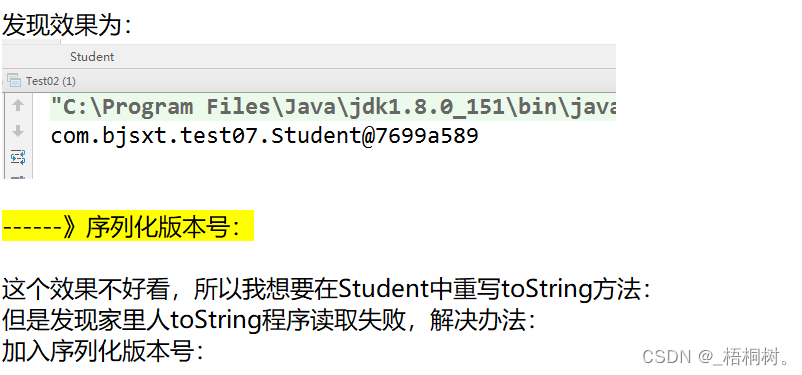
public class Student implements Serializable{
//加入一个序列化的版本号
private static final long serialVersionUID = -6237412967763134270L;
private String name;
private int age;
private double height;
private String sex;
public String getSex() {
return sex;
}
public void setSex(String sex) {
this.sex = sex;
}
public String getName() {
return name;
}
public void setName(String name) {
this.name = name;
}
public int getAge() {
return age;
}
public void setAge(int age) {
this.age = age;
}
public double getHeight() {
return height;
}
public void setHeight(double height) {
this.height = height;
}
public Student(String name, int age, double height) {
this.name = name;
this.age = age;
this.height = height;
}
@Override
public String toString() {
return "Student{" +
"name='" + name + '\'' +
", age=" + age +
", height=" + height +
'}';
}
}
PS:
(1)变量加上transient修饰,就不可以序列化
(2)变量被static修饰,也不可以被序列化
文件夹的复制
package com.bjsxt.test08;
import java.io.*;
public class Test {
public static void main(String[] args) throws IOException {
//复制文件夹:
copyDir(new File("d:/bjsxt"),new File("d:/bjsxt2"));
}
public static void copyDir(File srcFile,File targetFile) throws IOException {
//判断是否有目标文件夹:
if(!targetFile.exists()){//如果不存在我就创建
targetFile.mkdirs();
}
//开始复制:
File[] files=srcFile.listFiles();
for(File f:files){
if(f.isDirectory()){//如果f是文件夹,复制文件夹:
copyDir(new File(srcFile+"/"+f.getName()),new File(targetFile+"/"+f.getName()));
}else{ //如果f是文件,直接复制文件就可以:
copyFile(new File(srcFile+"/"+f.getName()),new File(targetFile+"/"+f.getName()));
}
}
}
//提取方法:文件的复制:
public static void copyFile(File srcFile,File targetFile) throws IOException {
//选取字节流:
BufferedInputStream bis=new BufferedInputStream(new FileInputStream(srcFile));
BufferedOutputStream bos=new BufferedOutputStream(new FileOutputStream(targetFile));
//开始动作:
byte[] b=new byte[1024];
int len=bis.read(b);
while(len!=-1){
bos.write(b,0,len);
len=bis.read(b);
}
//关闭流:
bos.close();
bis.close();
}
}
12、多线程
程序,进程,线程


线程创建的三种方式
第一种:继承Thread类

package com.bjsxt.test01;
//TestThread类,继承了Thread,它就具备了多线程的能力
//有个多线程的能力,就可以跟其它的线程争抢CPU资源
//TestThread线程类下的具体的对象就是线程对象。
public class TestThread extends Thread{
//一会要去争抢资源了,这个线程要做的任务是什么呢?将任务写到run方法中:
@Override
public void run() {
for (int i=1;i<=10;i++){
System.out.println("TestThread--------:"+i);
}
}
}
package com.bjsxt.test01;
public class Test {
//在我的程序中现在有三个线程:1.主线程 2.子线程tt 3.垃圾回收机制(忽略不计)
public static void main(String[] args) {//主线程
for(int i=1;i<=10;i++){
System.out.println("main方法(1)----------:"+i);
}
//创建一个子线程:TestThread的对象:
TestThread tt=new TestThread();//子线程
//tt.run();//想要执行子线程的任务
tt.start();//启动这个线程
//start方法是父类Thread中的方法:
//使该线程开始执行;Java 虚拟机调用该线程的 run 方法。
for(int i=1;i<=10;i++){
System.out.println("main方法(2)----------:"+i);
}
}
}
设置线程名字
【1】利用setName,getName方法:
package com.bjsxt.test01;
//TestThread类,继承了Thread,它就具备了多线程的能力
//有个多线程的能力,就可以跟其它的线程争抢CPU资源
//TestThread线程类下的具体的对象就是线程对象。
public class TestThread extends Thread{
//一会要去争抢资源了,这个线程要做的任务是什么呢?将任务写到run方法中:
@Override
public void run() {
for (int i=1;i<=10;i++){
System.out.println(this.getName()+i);
}
}
}
package com.bjsxt.test01;
public class Test {
//在我的程序中现在有三个线程:1.主线程 2.子线程tt 3.垃圾回收机制(忽略不计)
public static void main(String[] args) {//主线程
Thread.currentThread().setName("主线程");
for(int i=1;i<=10;i++){
System.out.println(Thread.currentThread().getName()+i);
}
//创建一个子线程:TestThread的对象:
TestThread tt=new TestThread();//子线程
tt.setName("这是第一个子线程:");
//tt.run();//想要执行子线程的任务
tt.start();//启动这个线程
//start方法是父类Thread中的方法:
//使该线程开始执行;Java 虚拟机调用该线程的 run 方法。
for(int i=1;i<=10;i++){
System.out.println(Thread.currentThread().getName()+i);
}
}
}
【2】利用有参构造器:
package com.bjsxt.test01;
//TestThread类,继承了Thread,它就具备了多线程的能力
//有个多线程的能力,就可以跟其它的线程争抢CPU资源
//TestThread线程类下的具体的对象就是线程对象。
public class TestThread extends Thread{
public TestThread(String name) {
super(name);
}
//一会要去争抢资源了,这个线程要做的任务是什么呢?将任务写到run方法中:
@Override
public void run() {
for (int i=1;i<=10;i++){
System.out.println(this.getName()+i);
}
}
}
package com.bjsxt.test01;
public class Test {
//在我的程序中现在有三个线程:1.主线程 2.子线程tt 3.垃圾回收机制(忽略不计)
public static void main(String[] args) {//主线程
Thread.currentThread().setName("主线程");
for(int i=1;i<=10;i++){
System.out.println(Thread.currentThread().getName()+i);
}
//创建一个子线程:TestThread的对象:
TestThread tt=new TestThread("子线程01111111:");//子线程
//tt.run();//想要执行子线程的任务
tt.start();//启动这个线程
//start方法是父类Thread中的方法:
//使该线程开始执行;Java 虚拟机调用该线程的 run 方法。
for(int i=1;i<=10;i++){
System.out.println(Thread.currentThread().getName()+i);
}
}
}
龟兔赛跑
package com.bjsxt.test02;
public class Tortoise extends Thread{//乌龟
//加一个有参构造器,一会用来设置线程的名字:
public Tortoise(String name) {
super(name);
}
//重写run方法:
@Override
public void run() {
while(true){
System.out.println("我是"+this.getName()+",我在跑,我现在领先了。。");
}
}
}
package com.bjsxt.test02;
public class Rabbit extends Thread {//兔子:
//用来设置线程名字的
public Rabbit(String name) {
super(name);
}
//重写run方法:
@Override
public void run() {
while(true){
System.out.println("我是"+this.getName()+",我没有偷懒,我也在跑。。。");
}
}
}
package com.bjsxt.test02;
public class Test {
public static void main(String[] args) {
//乌龟线程:
Tortoise tt=new Tortoise("乌龟线程:");
tt.start();
//兔子线程:
Rabbit rb=new Rabbit("兔子线程");
rb.start();
}
}
买火车票

package com.bjsxt.test03;
public class BuyTrainTicket extends Thread {
//属性:(不同窗口共享10张票)
private static int ticketNum=10;
//构造器:设置线程名字:设置窗口的名字:
public BuyTrainTicket(String name) {
super(name);
}
//每个窗口做什么事:写入run方法:
@Override
public void run() {
for(int i=1;i<=100;i++){
if(ticketNum>0){
System.out.println("我在"+this.getName()+"买到了从北京到哈尔滨的票,现在票剩余:"+(--ticketNum)+"张");
}
}
}
}
package com.bjsxt.test03;
public class Test {
public static void main(String[] args) {
//有几个线程?三个线程。,每个线程就是一个窗口:
BuyTrainTicket b1=new BuyTrainTicket("窗口1");
b1.start();
BuyTrainTicket b2=new BuyTrainTicket("窗口2");
b2.start();
BuyTrainTicket b3=new BuyTrainTicket("窗口3");
b3.start();
}
}

第二种:实现Runnable接口

package com.bjsxt.test04;
public class TestThread implements Runnable{
@Override
public void run() {
for(int i=1;i<=10;i++){
System.out.println(Thread.currentThread().getName()+"------:"+i);
}
}
}
package com.bjsxt.test04;
public class Test {
public static void main(String[] args) {//主线程
//创建子线程:
TestThread tt=new TestThread();
Thread t=new Thread(tt,"子线程");//通过构造器将Thread和TestThread进行了关联
t.start();
for(int i=1;i<=10;i++){
System.out.println("main----"+i);
}
}
}
扩展:静态代理模式
【1】案例:
吕鹏昌------》追求一个女生---------》找一个人帮他(赵珊珊)–》家聪聪

public interface Beirenzhui {//被人追
void maiHua();//买花
void maizuanjie();//买钻戒
}
public class JiaCongCong implements Beirenzhui {
@Override
public void maiHua() {
System.out.println("小雏菊。。。。");
}
@Override
public void maizuanjie() {
System.out.println("Darry ring。。。。。");
}
}
public class LiuFang implements Beirenzhui{
@Override
public void maiHua() {
System.out.println("玫瑰花");
}
@Override
public void maizuanjie() {
System.out.println("I do ..");
}
}
public class zhaoshanshan implements Beirenzhui{
// private JiaCongCong jcc=new JiaCongCong();
private Beirenzhui brz;
public zhaoshanshan(Beirenzhui brz){//Beirenzhui brz=new LiuFang();--->多态
this.brz=brz;//属性Beirenzhui brz=new LiuFang();
}
@Override
public void maizuanjie() {
brz.maizuanjie();
}
//代理中的方法比被代理的类中多!
public void findFlower(){
System.out.println("寻求卖花的合作厂商");
}
@Override
public void maiHua() {
findFlower();
brz.maiHua();
jiesuanMoney();
}
public void jiesuanMoney(){
System.out.println("结算钱。。。。");
}
}
public class LvPengchang {
public static void main(String[] args) {
//让代理赵珊珊给家聪聪买花,买钻戒:
zhaoshanshan zss=new zhaoshanshan(new LiuFang());
zss.maiHua();
zss.maizuanjie();
}
}
总结:代理:zhaoshanshan 被代理:家聪聪,刘芳
关联:利用代理的有参构造器
代理中方法要比被代理的方法 多!
龟兔赛跑
package com.bjsxt.test06;
public class Tortoise implements Runnable{//乌龟
@Override
public void run() {
while(true){
System.out.println(Thread.currentThread().getName()+"一直跑");
}
}
}
package com.bjsxt.test06;
public class Test {
public static void main(String[] args) {
//乌龟:
Tortoise tt=new Tortoise();
Thread t=new Thread(tt);
t.setName("乌龟");
t.start();
//兔子:参数为:匿名内部类
Thread t2=new Thread(new Runnable() {
@Override
public void run() {
while(true){
System.out.println("兔子一直在跑");
}
}
});
t2.start();
}
}
买火车票
package com.bjsxt.test07;
public class BuyTrainTicket implements Runnable {
private int ticketNum=10;
@Override
public void run() {
for(int i=1;i<=100;i++){
if(ticketNum>0){
System.out.println("我在"+Thread.currentThread().getName()+"买到了火车票,剩余"+(--ticketNum)+"张");
}
}
}
}
package com.bjsxt.test07;
public class Test {
public static void main(String[] args) {
BuyTrainTicket b=new BuyTrainTicket();
//窗口1:
new Thread(b,"窗口1").start();
//窗口2:
BuyTrainTicket b2=new BuyTrainTicket();
new Thread(b,"窗口2").start();
//窗口3:
BuyTrainTicket b3=new BuyTrainTicket();
new Thread(b,"窗口3").start();
}
}
第三种:实现Callable接口
【1】第一种和第二种的run方法的缺点:
public class Test implements Runnable{
@Override
public void run() {
}
}
缺点1:这个方法没有返回值。
缺点2:不能抛出异常
所以基于上面两个缺点,引入了方式3:
【3】方式3:JDK1.5以后为了解决上述缺点:
好处:call方法可以有返回值,还可以处理异常
缺点:线程创建比较麻烦
get方法是一个阻塞方法,什么时候线程代码执行完毕才会将返回值做一个获取。
package com.bjsxt.test08;
import java.util.Random;
import java.util.concurrent.Callable;
import java.util.concurrent.ExecutionException;
import java.util.concurrent.FutureTask;
public class RundomNum implements Callable<Integer>{//产生随机数的线程
//对于这个call方法来说,有返回值,返回值的类型跟泛型是一致的,并且对于这个方法是可以抛出异常的
@Override
public Integer call() /*throws Exception*/ {
System.out.println("--------");
try {
Thread.sleep(3000);
} catch (InterruptedException e) {
e.printStackTrace();
}
return new Random().nextInt(10);//生成10以内的随机数
}
public static void main(String[] args) throws ExecutionException, InterruptedException {
//创建线程对象:
RundomNum rn=new RundomNum();
FutureTask ft=new FutureTask(rn);
Thread t=new Thread(ft);
t.start();
//获取线程执行的结果:
//是一个阻塞的方法
System.out.println("当前线程是否在完成:"+ft.isDone());
Integer i=(Integer)(ft.get());//接收call方法的返回值的。
System.out.println(i);
System.out.println("当前线程是否在完成:"+ft.isDone());
}
}
总结
第一种和第二种哪个好?
java中只有单继承,所以用第二种实现接口的方式,还可以继承其他的类,
第三种好处:
(1)call方法有返回值
(2)可以抛出异常
线程的生命周期
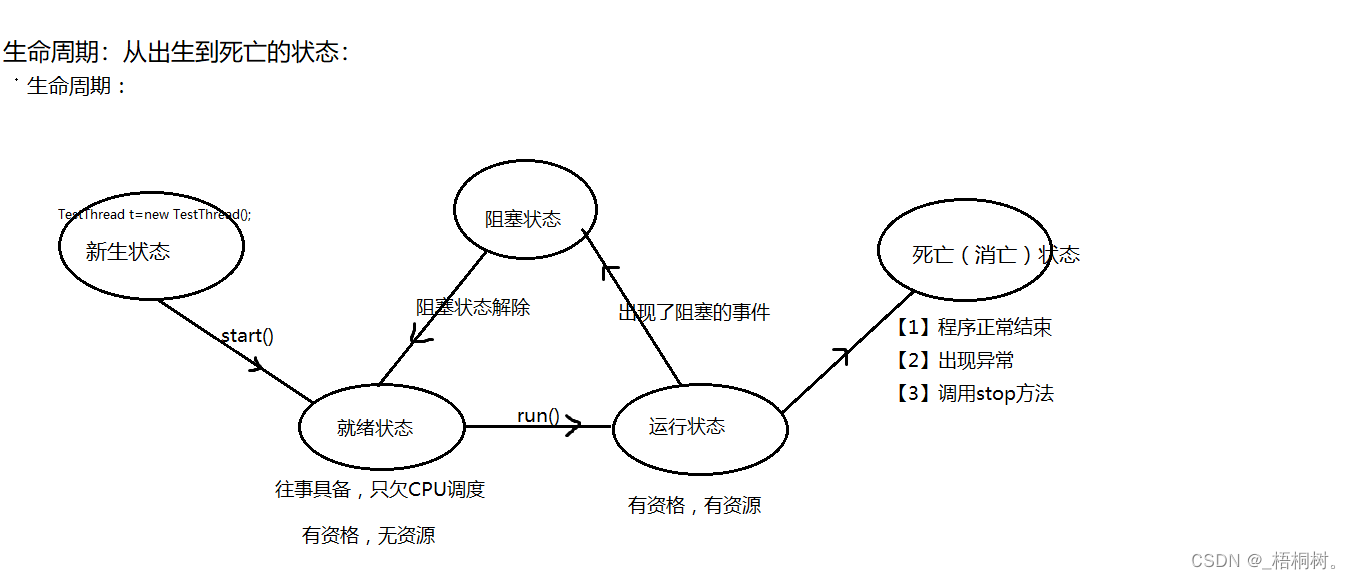
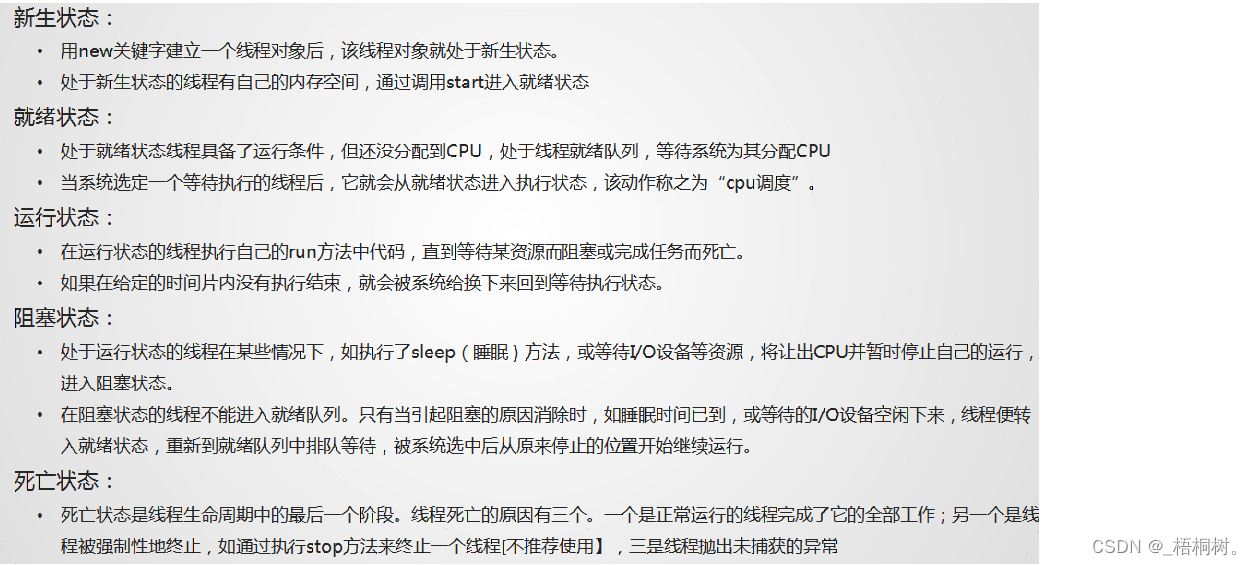
控制线程常用方法
优先级
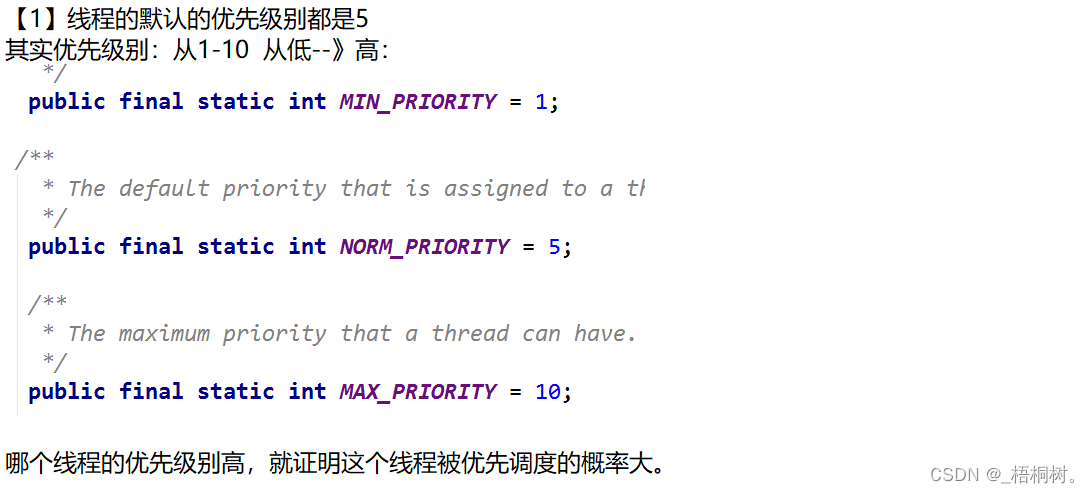
public class Tortoise extends Thread{//乌龟
//加一个有参构造器,一会用来设置线程的名字:
public Tortoise(String name) {
super(name);
}
//重写run方法:
@Override
public void run() {
while(true){
System.out.println("我是"+this.getName()+",我在跑,我现在领先了。。乌龟的优先级级别:"+this.getPriority());
}
}
}
package com.bjsxt.test02;
public class Rabbit extends Thread {//兔子:
//用来设置线程名字的
public Rabbit(String name) {
super(name);
}
//重写run方法:
@Override
public void run() {
while(true){
System.out.println("我是"+this.getName()+",我没有偷懒,我也在跑。。。兔子的优先级别:"+this.getPriority());
}
}
}
package com.bjsxt.test02;
public class Test {
public static void main(String[] args) {
//乌龟线程:
Tortoise tt=new Tortoise("乌龟线程:");
tt.setPriority(9);
tt.start();
//兔子线程:
Rabbit rb=new Rabbit("兔子线程");
rb.setPriority(1);
rb.start();
}
}
join
join方法:当一个线程调用了join方法,这个线程就会先被执行,它执行结束以后才可以去执行其余的线程。----“半路杀出个程咬金”
注意:必须先start,再join才有效。
package com.bjsxt.test09;
public class TestThread extends Thread {
@Override
public void run() {
for(int i=1;i<=10;i++){
System.out.println(this.getName()+"---------"+i);
}
}
public static void main(String[] args) throws InterruptedException {
for(int i=1;i<=10;i++){
if(i==6){
TestThread tt=new TestThread();
tt.start();
tt.join();//"半路杀出个程咬金"
}
System.out.println(Thread.currentThread().getName()+"-----"+i);
}
}
}
sleep
睡眠:
Thread.sleep(3000);//遇到这个方法,程序就被阻塞
//什么时候“睡完了”,这个阻塞就结束了
【1】龟兔赛跑加上裁判倒计时:
public class Test {
public static void main(String[] args) {
//裁判:喊: 3.。2 。。。1
for(int i=3;i>=1;i--){
System.out.println(i);
try {
Thread.sleep(1000);
} catch (InterruptedException e) {
e.printStackTrace();
}
}
//乌龟线程:
Tortoise tt=new Tortoise("乌龟线程:");
tt.setPriority(9);
tt.start();
//兔子线程:
Rabbit rb=new Rabbit("兔子线程");
rb.setPriority(1);
rb.start();
}
}
【2】完成一个秒表的功能:
package com.bjsxt.test09;
import java.text.DateFormat;
import java.text.SimpleDateFormat;
import java.util.Date;
public class Test {
public static void main(String[] args) {
//5.格式化提到while循环之外:
DateFormat df=new SimpleDateFormat("HH:mm:ss");
//3.加入死循环,让时间一直显示:
while(true){
//实现一个秒表:
//1.获取当前时间:
Date d=new Date();
//2.将时间按照我想要展现的格式展现:进行日期的格式化:
String strDate=df.format(d);
System.out.println(strDate);
//4.停顿一秒:
try {
Thread.sleep(1000);
} catch (InterruptedException e) {
e.printStackTrace();
}
}
}
}
yield()
package com.bjsxt.test10;
public class TestThread extends Thread {
public TestThread(String name) {
super(name);
}
@Override
public void run() {
for(int i=1;i<=10;i++){
System.out.println(this.getName()+"---"+i);
if(i==6){
Thread.yield();
//yield:暂停当前线程,使线程进入到就绪状态(不是阻塞,是就绪),进入到就绪状态以后等着CPU的调度,
可能立马被调用,也可能等着被调用。
}
}
}
public static void main(String[] args) {
//创建一个线程
TestThread t1=new TestThread("线程1");
t1.start();
//创建一个线程
TestThread t2=new TestThread("线程2");
t2.start();
}
}
setDaemon
设置伴随线程;
皇上 —》陪葬----》妃子
main主线程—》伴随线程----》DemoThread
但是在主线程结束以后,DemoThread “垂死挣扎”了一下,趁这个时间赶紧再执行一点代码:

package com.bjsxt.test10;
public class DemoThread extends Thread{
@Override
public void run() {
for(int i=1;i<=1000;i++){
System.out.println(this.getName()+"----"+i);
}
}
public static void main(String[] args) {
//子线程创建+启动:
DemoThread dt=new DemoThread();
dt.setName("子线程");
//将子线程设置为伴随线程:
dt.setDaemon(true);
dt.start();
for(int i=1;i<=10;i++){
System.out.println("main-----"+i);
}
}
}
stop
public class Test {
public static void main(String[] args) {
for(int i=1;i<=100;i++){
if(i==6){
Thread.currentThread().stop();
}
System.out.println(i);
}
}
}
线程安全、通信,线程池
线程安全问题

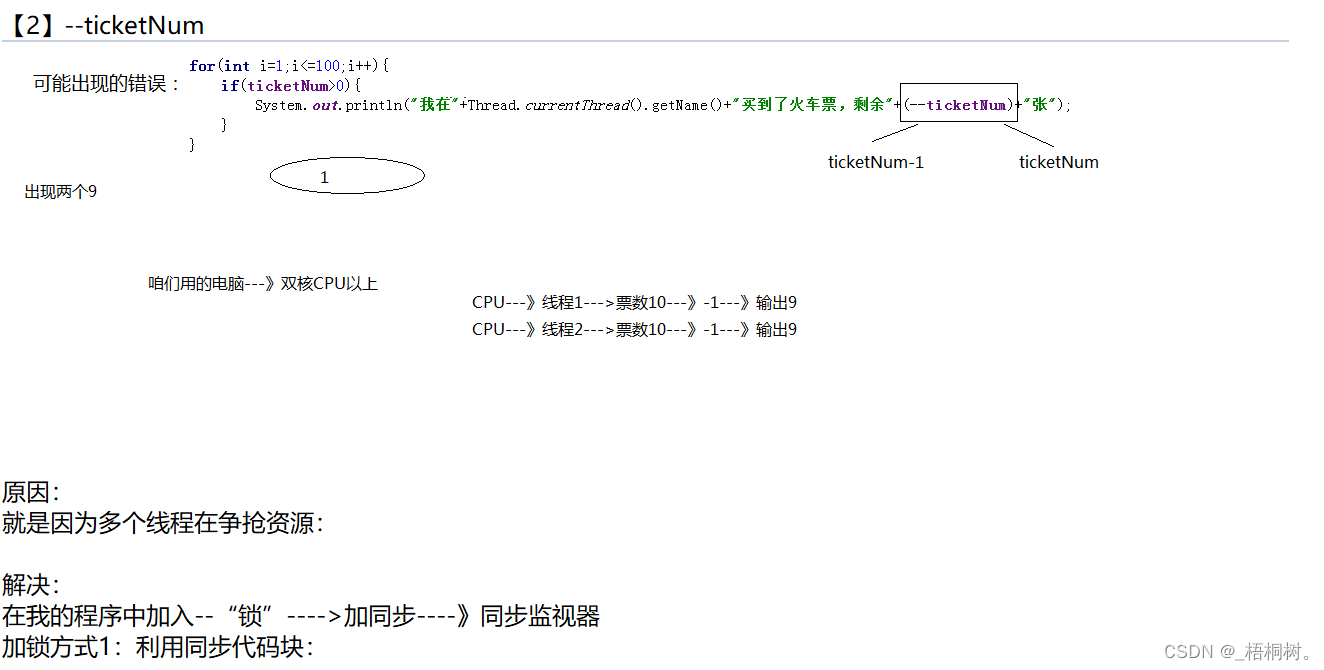
原因:
就是因为多个线程在争抢资源:
解决:
在我的程序中加入–“锁”---->加同步----》同步监视器
加锁方式1:利用同步代码块:
package com.bjsxt.test07;
public class BuyTrainTicket implements Runnable {
private int ticketNum=10;
@Override
public void run() {
for(int i=1;i<=100;i++){
synchronized (this){//锁:()中的内容:this
if(ticketNum>0){
try {
Thread.sleep(1000);
} catch (InterruptedException e) {
e.printStackTrace();
}
System.out.println("我在"+Thread.currentThread().getName()+"买到了火车票,剩余"+(--ticketNum)+"张");
//System.out.println("我在"+Thread.currentThread().getName()+"买到了火车票,买到了第"+(ticketNum--)+"张车票");
}
}
}
}
}
加锁方式2:利用同步方法:
package com.bjsxt.test07;
public class BuyTrainTicket implements Runnable {
private int ticketNum=10;
@Override
public void run() {
for(int i=1;i<=100;i++){
buyTicket();
}
}
//同步方法谁是锁? 锁的是this,谁调用方法就把谁锁了。
public synchronized void buyTicket(){
if(ticketNum>0){
try {
Thread.sleep(1000);
} catch (InterruptedException e) {
e.printStackTrace();
}
System.out.println("我在"+Thread.currentThread().getName()+"买到了火车票,剩余"+(--ticketNum)+"张");
//System.out.println("我在"+Thread.currentThread().getName()+"买到了火车票,买到了第"+(ticketNum--)+"张车票");
}
}
}
加了同步,代码的执行过程是什么样的?
线程1:进入到run方法中,看到程序中有锁,但是没有锁住,然后它将这个锁锁住。
其他的线程可以进来,但是看到锁被锁住了,只能等着,
等到什么时候啊?等到线程1完事了,将锁进行释放,释放完了之后其余的线程就可以将这个锁抢过去了,然后谁抢到谁再加上锁。
--------》
另一个火车票的代码:
package com.bjsxt.test03;
public class BuyTrainTicket extends Thread {
//属性:(不同窗口共享10张票)
private static int ticketNum=10;
//构造器:设置线程名字:设置窗口的名字:
public BuyTrainTicket(String name) {
super(name);
}
//每个窗口做什么事:写入run方法:
@Override
public void run() {
for(int i=1;i<=100;i++){
synchronized (BuyTrainTicket.class){//"abc"---只能将引用数据类型作为锁
try {
Thread.sleep(1000);
} catch (InterruptedException e) {
e.printStackTrace();
}
if(ticketNum>0){
System.out.println("我在"+this.getName()+"买到了从北京到哈尔滨的票,现在票剩余:"+(--ticketNum)+"张");
}
}
}
}
}
总结:
多线程在争抢资源,就要实现线程的同步(就要进行加锁),
并且这个锁必须是共享的,必须是唯一的。
咱们的锁一般都是引用数据类型的。
目的:解决了线程安全问题。
习题
银行卡:主卡 和 副卡
男主人 女主人—》主卡 和 副卡
package com.bjsxt.test11;
public class AccoutThread implements Runnable{
//共享账号:
private Account ac=new Account();
@Override
public void run() {
/*synchronized (this){
if(ac.getBalance()>=400){
ac.getMoney(300);
System.out.println(Thread.currentThread().getName()+"在取款,取款后余额为:"+ac.getBalance());
}else{
System.out.println(Thread.currentThread().getName()+"在取款,但是余额不足400,取款失败");
}
}*/
getM();
}
public synchronized void getM(){
if(ac.getBalance()>=400){
ac.getMoney(300);
System.out.println(Thread.currentThread().getName()+"在取款,取款后余额为:"+ac.getBalance());
}else{
System.out.println(Thread.currentThread().getName()+"在取款,但是余额不足400,取款失败");
}
}
}
package com.bjsxt.test11;
public class Account {
//共享钱:
int money=600;
//取钱
public void getMoney(int money){
this.money-=money;//this.money=this.money-money
}
//得到余额
public int getBalance(){
return money;
}
}
package com.bjsxt.test11;
public class Test {
public static void main(String[] args) {
AccoutThread ac=new AccoutThread();
new Thread(ac,"男主人").start();
new Thread(ac,"女主人").start();
}
}
线程同步的缺点
【1】
线程安全,效率低
线程不安全,效率高
【2】可能造成死锁:
public class TestDeadLock implements Runnable {
public int flag = 1;
static Object o1 = new Object(),o2 = new Object();
public void run(){
System.out.println("flag=" + flag);
// 当flag==1锁住o1
if (flag == 1) {
synchronized (o1) {
try {
Thread.sleep(500);
} catch (Exception e) {
e.printStackTrace();
}
// 只要锁住o2就完成
synchronized (o2) {
System.out.println("2");
}
}
}
// 如果flag==0锁住o2
if (flag == 0) {
synchronized (o2) {
try {
Thread.sleep(500);
} catch (Exception e) {
e.printStackTrace();
}
// 只要锁住o1就完成
synchronized (o1) {
System.out.println("3");
}
}
}
}
public static void main(String[] args) {
// 实例2个线程类
TestDeadLock td1 = new TestDeadLock();
TestDeadLock td2 = new TestDeadLock();
td1.flag = 1;
td2.flag = 0;
// 开启2个线程
Thread t1 = new Thread(td1);
Thread t2 = new Thread(td2);
t1.start();
t2.start();
}
}
疑问1:
(1)
static去掉,还会死锁吗?不会
(2)如何解决死锁?

Lock锁
Lock锁:
JDK1.5后新增功能,
与采用synchronized相比,lock可提供多种锁方案,更灵活
注意:如果同步代码有异常,要将unlock()写入finally语句块
ReentrantLock 类实现了 Lock ,它拥有与 synchronized 相同的并发性和内存语义,
但是添加了类似锁投票、定时锁等候和可中断锁等候的一些特性。
此外,它还提供了在激烈争用情况下更佳的性能。
Lock和synchronized的区别
1.Lock是显式锁(手动开启和关闭锁,别忘记关闭锁),synchronized是隐式锁
2.Lock只有代码块锁,synchronized有代码块锁和方法锁
3.使用Lock锁,JVM将花费较少的时间来调度线程,性能更好。并且具有更好的扩展性(提供更多的子类)
优先使用顺序:
Lock----同步代码块(已经进入了方法体,分配了相应资源)----同步方法(在方法体之外)
package com.bjsxt.test07;
import java.util.concurrent.locks.Lock;
import java.util.concurrent.locks.ReentrantLock;
public class BuyTrainTicket implements Runnable {
private int ticketNum=10;
//"买来一把锁":
Lock lock=new ReentrantLock();//多态
@Override
public void run() {
for(int i=1;i<=100;i++){
//打开锁
lock.lock();
try{
if(ticketNum>0){
try {
Thread.sleep(1000);
} catch (InterruptedException e) {
e.printStackTrace();
}
System.out.println("我在"+Thread.currentThread().getName()+"买到了火车票,剩余"+(--ticketNum)+"张");
}
}catch(Exception ex){
ex.printStackTrace();
}finally {
//关闭锁
lock.unlock();
}
}
}
}
线程组
package com.bjsxt.test12;
public class TestThread extends Thread{
public TestThread() {
}
//两个参数:第一个参数设置线程所在的线程组,第二个参数:设置线程的名字的
public TestThread(ThreadGroup group, String name) {
super(group, name);
}
@Override
public void run() {
for (int i=1;i<=10;i++){
System.out.println(i);
}
}
//设置线程名字
public TestThread(String name) {
super(name);
}
public static void main(String[] args) {
TestThread tt=new TestThread();
tt.setName("这是一个线程名字");
System.out.println(tt.toString());
//Thread[Thread-0,5,main]-->线程名字,优先级别,线程组名字:
System.out.println(tt.getThreadGroup().getName());//main
System.out.println(tt.getThreadGroup().getParent().getName());//上层组:system
System.out.println(tt.getThreadGroup().getParent().getParent());//null
//创建一个线程组:
ThreadGroup tg=new ThreadGroup("我的线程组哈哈哈");
System.out.println(tg.getName());
TestThread t1=new TestThread(tg,"线程1");
TestThread t2=new TestThread(tg,"线程2");
System.out.println(t1.getThreadGroup().getName());
System.out.println(t1.getThreadGroup().getParent().getName());
t1.start();
t2.start();
System.out.println("------------");
tg.list();
}
}
线程之间的通信问题
应用场景:生产者和消费者问题
假设仓库中只能存放一件产品,生产者将生产出来的产品放入仓库,消费者将仓库中产品取走消费
如果仓库中没有产品,则生产者将产品放入仓库,否则停止生产并等待,直到仓库中的产品被消费者取走为止
如果仓库中放有产品,则消费者可以将产品取走消费,否则停止消费并等待,直到仓库中再次放入产品为止

最终代码结果:


代码分析:
商品:被生产者和消费者共享:商品属性:品牌,名字
线程1:生产者
线程2:消费者
分解1:
package com.bjsxt.test13;
public class Product {//商品
//属性:
//品牌
private String brand;
//名字
private String name;
//提供setget方法:
public String getBrand() {
return brand;
}
public void setBrand(String brand) {
this.brand = brand;
}
public String getName() {
return name;
}
public void setName(String name) {
this.name = name;
}
}
package com.bjsxt.test13;
public class ProducerThread extends Thread {//生产者线程
//共享商品:
private Product p;
public ProducerThread(Product p){
this.p=p;
}
//重写run方法:
@Override
public void run() {
for(int i=1;i<=10;i++){
if(i%2==0){
//费列罗巧克力:
p.setBrand("费列罗");
try {
Thread.sleep(100);
} catch (InterruptedException e) {
e.printStackTrace();
}
p.setName("巧克力");
}else{
p.setBrand("哈尔滨");
try {
Thread.sleep(100);
} catch (InterruptedException e) {
e.printStackTrace();
}
p.setName("啤酒");
}
//将信息打印:
System.out.println("生产者生产了:"+p.getBrand()+"----"+p.getName());
}
}
}
package com.bjsxt.test13;
public class CustomerThread extends Thread {//消费者线程
private Product p;
public CustomerThread(Product p){
this.p=p;
}
//重写run方法:
@Override
public void run() {
for (int i=1;i<=10;i++){
System.out.println("消费者消费,消费了:"+p.getBrand()+"----"+p.getName());
}
}
}
package com.bjsxt.test13;
public class Test {
public static void main(String[] args) {
//创建一个共享商品:
Product p=new Product();
//创建生产者和消费者线程:
CustomerThread ct=new CustomerThread(p);
ProducerThread pt=new ProducerThread(p);
pt.start();
ct.start();
}
}
代码出现的问题:
(1)没有交替生产和消费
正常效果生产一个消费一个,但是现在生产好几个,消费好几个。
(2)打印数据错乱:
哈尔滨 null
哈尔滨 巧克力
费列罗啤酒
分解2:
【1】加锁:利用同步代码块:
package com.bjsxt.test14.test13;
public class Product {//商品
//属性:
//品牌
private String brand;
//名字
private String name;
//提供setget方法:
public String getBrand() {
return brand;
}
public void setBrand(String brand) {
this.brand = brand;
}
public String getName() {
return name;
}
public void setName(String name) {
this.name = name;
}
}
package com.bjsxt.test14.test13;
public class ProducerThread extends Thread {//生产者线程
//共享商品:
private Product p;
public ProducerThread(Product p){
this.p=p;
}
//重写run方法:
@Override
public void run() {
for(int i=1;i<=10;i++){
synchronized (p){
if(i%2==0){
//费列罗巧克力:
p.setBrand("费列罗");
try {
Thread.sleep(100);
} catch (InterruptedException e) {
e.printStackTrace();
}
p.setName("巧克力");
}else{
p.setBrand("哈尔滨");
try {
Thread.sleep(100);
} catch (InterruptedException e) {
e.printStackTrace();
}
p.setName("啤酒");
}
//将信息打印:
System.out.println("生产者生产了:"+p.getBrand()+"----"+p.getName());
}
}
}
}
package com.bjsxt.test14.test13;
public class CustomerThread extends Thread {//消费者线程
private Product p;
public CustomerThread(Product p){
this.p=p;
}
//重写run方法:
@Override
public void run() {
for (int i=1;i<=10;i++){
synchronized (p){
try {
Thread.sleep(100);
} catch (InterruptedException e) {
e.printStackTrace();
}
System.out.println("消费者消费,消费了:"+p.getBrand()+"----"+p.getName());
}
}
}
}
package com.bjsxt.test14.test13;
public class Test {
public static void main(String[] args) {
//创建一个共享商品:
Product p=new Product();
//创建生产者和消费者线程:
CustomerThread ct=new CustomerThread(p);
ProducerThread pt=new ProducerThread(p);
pt.start();
ct.start();
}
}
【2】加锁:同步方法:
package com.bjsxt.test15.test13;
public class Product {//商品
//属性:
//品牌
private String brand;
//名字
private String name;
//提供setget方法:
public String getBrand() {
return brand;
}
public void setBrand(String brand) {
this.brand = brand;
}
public String getName() {
return name;
}
public void setName(String name) {
this.name = name;
}
//生产产品:
public synchronized void setProduct(String brand,String name){
this.setBrand(brand);
try {
Thread.sleep(100);
} catch (InterruptedException e) {
e.printStackTrace();
}
this.setName(name);
//将信息打印:
System.out.println("生产者生产了:"+this.getBrand()+"----"+this.getName());
}
//消费商品
public synchronized void getProduct(){
try {
Thread.sleep(100);
} catch (InterruptedException e) {
e.printStackTrace();
}
System.out.println("消费者消费,消费了:"+this.getBrand()+"----"+this.getName());
}
}
package com.bjsxt.test15.test13;
public class CustomerThread extends Thread {//消费者线程
private Product p;
public CustomerThread(Product p){
this.p=p;
}
//重写run方法:
@Override
public void run() {
for (int i=1;i<=10;i++){
p.getProduct();
}
}
}
package com.bjsxt.test15.test13;
public class ProducerThread extends Thread {//生产者线程
//共享商品:
private Product p;
public ProducerThread(Product p){
this.p=p;
}
//重写run方法:
@Override
public void run() {
for(int i=1;i<=10;i++){
if(i%2==0){
//费列罗巧克力:
p.setProduct("费列罗","巧克力");
}else{
p.setProduct("哈尔滨","啤酒");
}
}
}
}
package com.bjsxt.test15.test13;
public class Test {
public static void main(String[] args) {
//创建一个共享商品:
Product p=new Product();
//创建生产者和消费者线程:
CustomerThread ct=new CustomerThread(p);
ProducerThread pt=new ProducerThread(p);
pt.start();
ct.start();
}
}
现在代码中还有的问题:生产和消费并没有交替进行;
分解3:

package com.bjsxt.test15.test13;
public class Product {//商品
//属性:
//品牌
private String brand;
//名字
private String name;
//加入一个“灯”:
boolean flag=false;//最开始这个灯应该是绿色的:false--》没有商品
//提供setget方法:
public String getBrand() {
return brand;
}
public void setBrand(String brand) {
this.brand = brand;
}
public String getName() {
return name;
}
public void setName(String name) {
this.name = name;
}
//生产产品:
public synchronized void setProduct(String brand,String name){
if(flag==true){//灯是红色:生产者不生产的,等着
try {
wait();//Object的方法
} catch (InterruptedException e) {
e.printStackTrace();
}
}
//如果灯是绿色的呢?开始生产商品:
this.setBrand(brand);
try {
Thread.sleep(100);
} catch (InterruptedException e) {
e.printStackTrace();
}
this.setName(name);
//将信息打印:
System.out.println("生产者生产了:"+this.getBrand()+"----"+this.getName());
//截止到上面,商品已经生产完了:
//将灯变成:红色
flag=true;
//告诉消费者赶紧来消费:
notify();//Object类方法
}
//消费商品
public synchronized void getProduct(){
if(!flag){//flag==false--->如果灯是绿色的:
try {
wait();
} catch (InterruptedException e) {
e.printStackTrace();
}
}
//如果灯是红色的:开始消费:
try {
Thread.sleep(100);
} catch (InterruptedException e) {
e.printStackTrace();
}
System.out.println("消费者消费,消费了:"+this.getBrand()+"----"+this.getName());
//截止到这里,消费结束
//灯变成:绿色:
flag=false;
//通知生产者赶紧生产:
notify();
}
}
package com.bjsxt.test15.test13;
public class ProducerThread extends Thread {//生产者线程
//共享商品:
private Product p;
public ProducerThread(Product p){
this.p=p;
}
//重写run方法:
@Override
public void run() {
for(int i=1;i<=10;i++){
if(i%2==0){
//费列罗巧克力:
p.setProduct("费列罗","巧克力");
}else{
p.setProduct("哈尔滨","啤酒");
}
}
}
}
package com.bjsxt.test15.test13;
public class CustomerThread extends Thread {//消费者线程
private Product p;
public CustomerThread(Product p){
this.p=p;
}
//重写run方法:
@Override
public void run() {
for (int i=1;i<=10;i++){
p.getProduct();
}
}
}
package com.bjsxt.test15.test13;
public class Test {
public static void main(String[] args) {
//创建一个共享商品:
Product p=new Product();
//创建生产者和消费者线程:
CustomerThread ct=new CustomerThread(p);
ProducerThread pt=new ProducerThread(p);
pt.start();
ct.start();
}
}

线程池
队列

线程池

内置线程池
JDK1.5之后提供了内置线程池:
【1】可缓存线程池:
public class Test {
public static void main(String[] args) {
//可缓存线程:
ExecutorService es = Executors.newCachedThreadPool();
//执行任务:
for(int i=1;i<=100;i++){
es.execute(new TestThread());
}
//关闭:
es.shutdown();
}
}
最开始没有核心线程,来一个任务,新建一个线程来执行这个任务,当这个任务执行完以后,这个线程继续执行其他的任务,所以在结果中我们发现,线程可以是重复的:

【2】定长线程池:
public class Test {
public static void main(String[] args) {
//定长线程:
ExecutorService es = Executors.newFixedThreadPool(3);
//执行任务:
for(int i=1;i<=100;i++){
es.execute(new TestThread());
}
//关闭:
es.shutdown();
}
}

【3】定时线程池:
public class Test {
public static void main(String[] args) {
//定时线程:
ScheduledExecutorService ses=Executors.newScheduledThreadPool(3);
//执行任务:
for(int i=1;i<=100;i++){
ses.schedule(new TestThread(),3, TimeUnit.SECONDS);
}
//关闭:
ses.shutdown();
}
}
进行延时:延时3秒执行线程
【4】单例线程池:
public class Test {
public static void main(String[] args) {
//单例线程:
ExecutorService es= Executors.newSingleThreadExecutor();
//执行任务:
for(int i=1;i<=100;i++){
es.execute(new TestThread());
}
//关闭:
es.shutdown();
}
}
就是由一个线程来执行任务
public class Test {
public static void main(String[] args) {
//单例线程:
ExecutorService es= Executors.newSingleThreadExecutor();
//执行任务:
for(int i=1;i<=100;i++){
//利用匿名内部类的对象传入execute方法也是可以的:
es.execute(new Runnable() {
@Override
public void run() {
System.out.println("当前线程为:"+Thread.currentThread().getName());
}
});
}
//关闭:
es.shutdown();
}
}


















